Water Adventures to Kick Off Summer
The Pickleball Craze Starts in Austin



Water Adventures to Kick Off Summer
The Pickleball Craze Starts in Austin


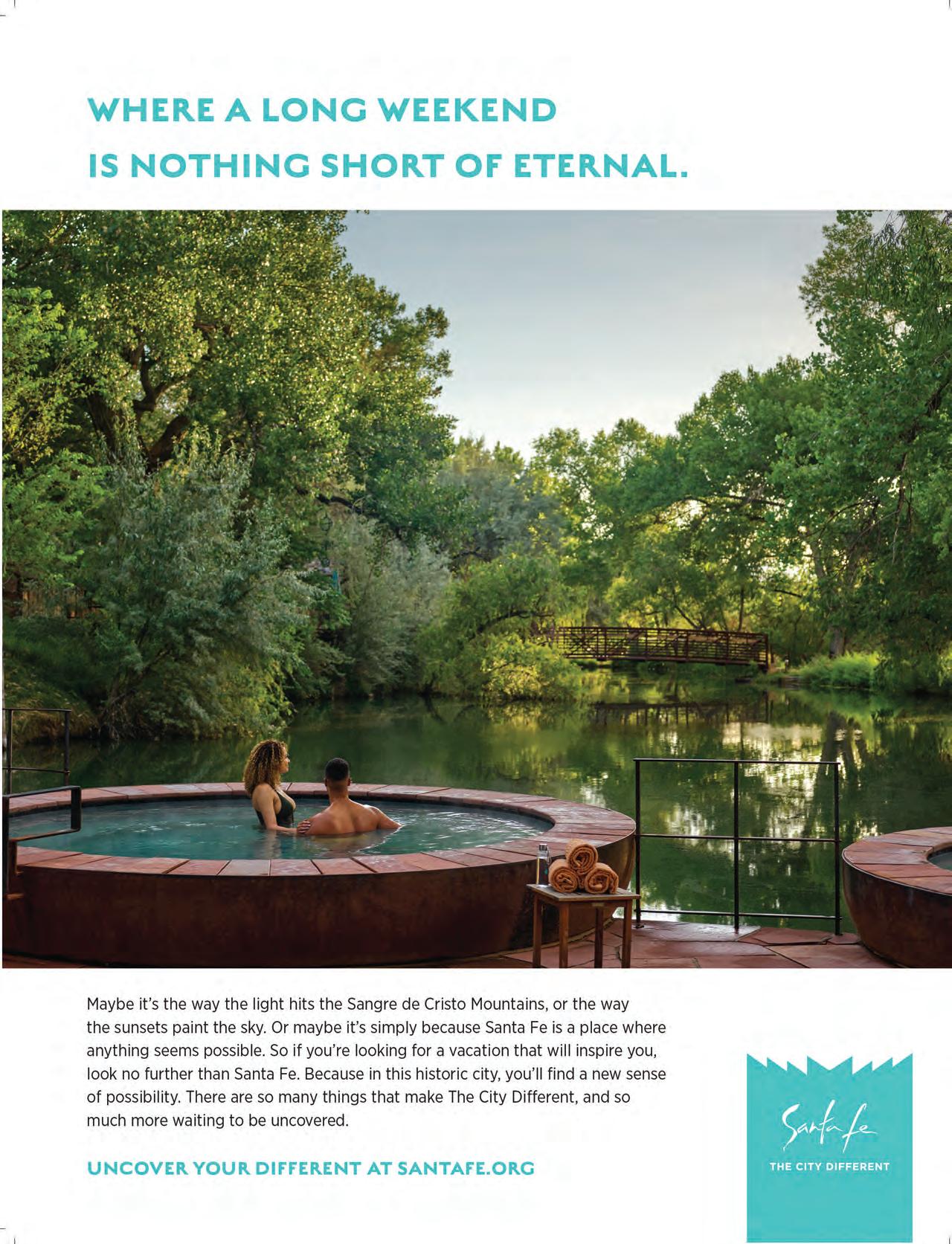









Experience the life aquatic as you dive into the state’s best water parks, ocean attractions, fishing spots, and underwater activities this season.
62
The Sky’s the Limit
Top Gun: Maverick was just the beginning for Austin’s biggest new star, Glen Powell.
70
The Pickleball King of Dripping Springs
Billionaire Steve Kuhn’s vast dominion isn’t just a pickleball hub. It’s a monument to the American dream.



When city boys go country: Beware the rise of big shtick energy 20
Bon voyage! ATX now boasts 95-plus direct flights 22
Five gripping new reads by local authors 24
It’s Japan-by-way-of-Mexico at Ramen del Barrio 28
Want to be an Austin restaurateur? Here’s what to know 30
A new Lockhart spot is shaking up Texas’ barbecue capital 32
The no-kill dilemma that’s creating a pet crisis 36
Laurie Gallardo on 20 years of radio magic 38
Move aside, Tesla. A new autonomous vehicle company is taking charge 40





Editor in Chief
Chris Hughes
Creative Director
Sara Marie D’Eugenio
EDITORIAL
Executive Editor
Madeline Hollern
Associate Editor
Bryan C. Parker
Contributing Writers
Lauren Larson, Saba Rahimian, Gregory Wakeman, Amanda Eyre Ward
ART
Contributing Photographers
Dave Creaney, Robby Klein, Phil Kline
Contributing Illustrators
Chris Gash, Charlie Powell
DIGITAL
Digital Managers
Rosie Ninesling, Abigail Stewart
INTERNS
Brenna Erwin, Skyler Moore
ADVERTISING
Senior Account Executive
Tina Mullins
Account Director
Dana Horner
Account Executives
Annemarie Gist, Julia Grisemer
Sales Operation Manager
Kiely Whelan
EVENTS
Events Director
Lauren Sposetta
CEO
Todd P. Paul
Editorial Director
Rebecca Fontenot Cord
Director of Operations
Hollis Boice
Audience Development Director
Kerri Nolan
Circulation Manager
Julie Becker
Accounting Manager
Sabina Jukovic
Mailing Address 1712 Rio Grande St., Ste. 100 Austin, TX 78701 (512) 263-9133
Advertising Inquiries
advertising@austinmonthly.com
Job Inquiries jobs@austinmonthly.com
Story Ideas ideas@austinmonthly.com Letters to the Editor feedback@austinmonthly.com
Subscriptions, Renewals, and Address Changes
Open Sky Media, Inc.
512 W. MLK Jr. Blvd., PMB 374 Austin, TX 78701-1231 (512) 387-6234
subscriptions@austinmonthly.com austinmonthly.com/subscribe Back Issues and Bulk Orders info@austinmonthly.com or (512) 263-9133





DURING A PARTICULARLY messy breakup in my late20s, I found myself unmoored. This was both figurative and literal, as serious plans for the future had been dashed upon the rocky shores of heartbreak, while also leaving me, literally, without a home (after our separation, she kept the Brentwood rental). In that foggy state of purgatory, my oldest friend, Jeff, invited me to stay with his family at their beach house on South Padre Island. And like a half-inflated balloon, relenting to the whims of the winds, I drifted into his car—not exactly enthused, but also not fighting the gesture—and headed for the coast.
As a person more prone to the indoors, I don’t think I even owned a pair of swim trunks. But as we passed the Freddy Fender water tower in San Benito, and salt air began to drift through our cracked windows, my mood lightened. By the time my toes dug into the soft sands of Isla Blanca Beach, and sunlight washed over my closed eyelids in a scarlet curtain, I felt renewed.
That was only accentuated when we visited the Laguna Atascosa National Wildlife Rescue, where hundreds of migratory birds congregate on its tidal flats. Established in 1946, the former U.S. Army gunnery range is now home to species as wide-ranging as the Bullock’s oriole, Mexican ground squirrels, grey foxes, and the endangered ocelot. Like all the flora and fauna scattered upon its thousands of acres of diverse, unspoiled habitat, it was largely drawn by water. Akin to the lullaby of lapping waves close by on South Padre’s beaches, it serves as a rejuvenating refuge.
Perhaps it’s that innate ability to heal that inspires us to take to the road every summer in search of the closest lake, river, or sandy shore. Almost certainly, it’s why executive editor Madeline Hollern—when tasked with a weekend getaway feature—focused on the aquatic. In “Wet Hot Texas Summer” (p. 50), she scoured the state to unearth the best paddleboard adventures, saltwater fishing excursions, and, yes, beaches like the Padre Island National Seashore. Even on a glow-in-the-dark kayak trip or a slide down one of Schlitterbahn’s many chutes, there’s a sense of escape that puts nature ahead of our own trivial problems.
Today, I can hardly imagine the pains that wracked me that distant summer. The emotions have washed away like the tides. But what remains are the consolations of a friend, the sight of mottled ducks sweeping over marshland, and the perspective that can only be afforded by water.

Chris Hughes Editor in Chief chughes@austinmonthly.com @cmhughestx @chris_hughestx






Don’t consider yourself a hat person? Laura Del Villaggio of Milli Starr says there’s no such thing. For more than 20 years, she’s hand-sewn couture fascinators and one-of-a-kind wearable art pieces for local and international fans alike. While Del Villaggio is typically flooded with Kentucky Derby requests before the May event— one client even named a racehorse in her honor—wedding season and the royal coronation have made this spring particularly busy for her. Often utilizing dead stock vintage materials such as 30-year-old parisisal straw capelines, the Fashion Institute of Technology–trained milliner takes up to 100 hours to craft her creations and adds embellishments like hand-curled feather quills and hand-dyed silk roses. While she says her distinct style honors history, it also brings the past into new light: “I’m trying to make a 19th- and early 20th-century art form relevant to today.” millistarr.com
—Rosie Ninesling
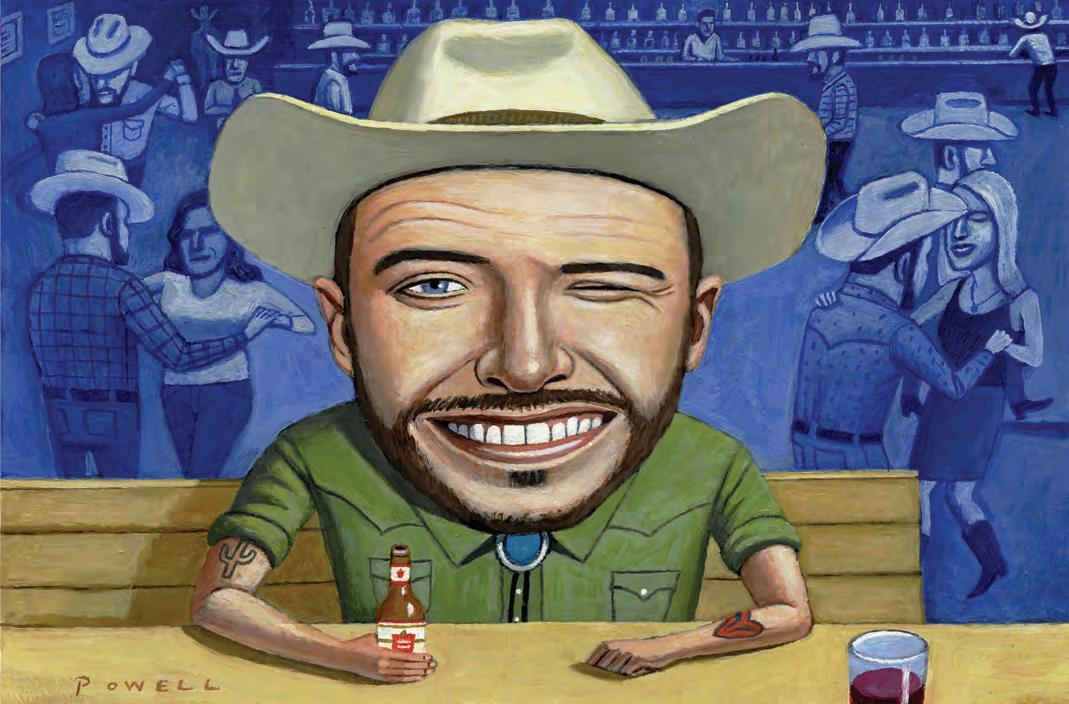
Meet the F-150-driving, belt buckle–wearing, two-steppin’ city boys invading dating apps.
BY LAUREN LARSON
LOOKING BACK, THE signs were all there. The tagline on his Tinder profile was “Mama raised me to treat the cowgirls right,” and all his photos had horses in them, but his corporate job had you fooled. When he pulled up to your place, he was blasting Charley Crockett from a 1987 Ford pickup that he futzes around with every weekend and which, he’ll tell you, “saved his life.” Like Owen Wilson transported back to 1920s Paris in a Peugeot in Midnight in Paris, so this man would deliver you to an imagined frontier Austin in his crappy truck.
But it is only when you arrive at his chosen lounge that you confirm it: Your date has big shtick energy. The bar’s light fixtures are shrouded in rawhide. Its walls display the kind of tchotchkes that a hometown bar accumulates over decades—think herds of taxidermied critters, a cluster of creepy dolls up in the rafters, and old Playboys stacked on a coffee
table. These items would be charming in a dive that had actually been around for decades, but the thought of someone curating them ahead of the space’s opening last December is unsettling.
He guides you up to the bar with just the whisper of his hand on the small of your back, then orders a Lone Star. “What’ll ya have, darlin’?” he asks. You order a beet juice–based cocktail with mezcal and Nixta Liquor De Elote. It’s fantastic, but it comes in a koozie made from a severed white sock, which, when stained with beet juice, appears bloodied.
You sit down on a bench, watched over by seven buck heads. Your date slouches back and spreads his arms over the back of his bench. He looks at you expectantly, so you begin commenting on his accessories. First you say “Nice hat,” because he is wearing a white cowboy hat with a woven band. “You don’t choose a hat like this. It chooses you,” he notes. You ask him whether his belt buckle also chose him. He laughs. “You’re a funny one.” You don’t know what to say to this, so you point out that the belt buckle is really big. Now you’re worried that you sound suggestive, but he agrees: “It’s a big ’un, like a tick on a speck of that ol’ Marfa dust.”
Marfa will always be home to him, he adds. Prior to agreeing to this date, you conducted a perfunctory background check, assisted by LinkedIn, so you know he grew up in Chicago. “Never been much for cities,” he says, “but city girls sure are
Arriving at his chosen bar, you realize: He’s got big shtick energy.
pretty.” He actually winks at you. He has one stickand-poke tattoo of a cactus, and another of two pistols that come together to make a heart shape. He does not own guns himself, you see, but he appreciates them.
His real love is music, especially the early work of George Strait. He cannot name a particular song he loves from Strait’s early oeuvre, but that’s because it would be like picking a favorite child. You ask where he’s from, trying to keep your expression neutral. “Lil’ town up north,” he says quickly, then offers to get you two a round of lagers. Beer makes you puffy, and you would’ve preferred another beet drink in a bloody sock, but you agree.
The energy, you realize while he’s at the bar, has begun to permeate you. You’ve gone on 17 dates with software engineers in the past 30 days, and at least the identity that this man is cosplaying is not “tech tyrant.” You have felt the call of big shtick energy yourself once before, when you accidentally greeted a barista in a twang due to a sinus infection, and spoke in an exaggerated accent for the rest of the transaction.
When your date returns to the table, he leans in and asks whether you’d let him take you on a few spins around a nearby honky-tonk: a tucked-away little dance hall he stumbled upon one starry night. “Yeehaw yippee wee-woo darlin’ yeah,” you reply. You’re speaking in tongues now. You slam your beer, settle up, and pile into the prized F-150, which you now see is very much not up to code. This, too, is part of the shtick. It’s filled every crevice of his life like the dirt on a caliche road fills every cranny on a man’s face.
The special little place that he knows is The White Horse, and even though it’s basically Austin’s Union Pool, you let him have this. He calls it “his slice of heaven.” Although you’re here with some regularity, lured by your one friend who enjoys two-stepping, you’ve never seen him once. He only brought enough cash for his own $10 cover, and you consider simply going home, but, you think to yourself in the voice of Leonardo DiCaprio in Titanic, you’re involved now. You fish $10 out of your purse and follow him inside.
In The White Horse, the shtick is effervescent. It glows on your date like daylight on Robert Pattinson in Twilight. He whirls you around. He is talking to you, but you can only hear occasional words and phrases over the music: BACK HOME! RATTLER! DANG OL’! SAVED MY LIFE! You pause the dance one move into a two-step, guide him up to the bar, and order a Lone Star. “And for the gentleman?” you ask coyly.
He orders himself a gin and tonic and looks at you funny. The transference is complete.

BY MADELINE HOLLERN
Amsterdam
Airline: KLM Royal Dutch
When It Debuted: March 2022
Flight Duration: 9 hours 25 minutes
When It’s Available: Mondays, Thursdays, and Saturdays

Airline: Lufthansa
GONE ARE THE days of getting stuck in Dallas or Houston with a lengthy layover. As the capital city inches its way toward the top 10 biggest U.S. cities—it’s currently No. 11— Austin-Bergstrom International Airport continues to expand its direct flights, now servicing 95-plus national and international destinations from London, England, to Liberia, Costa Rica. (It’s even been reported that a direct flight to Asia could be announced by year’s end.) Planning your summer getaway? Head to one of these six new international destinations.

Airline: Southwest
When It Debuted: June 2022
Flight Duration: 2 hours 30 minutes
When It’s Available: Saturdays, mid-June through Labor Day
When It Debuted: Suspended in March 2020 during the COVID-19 pandemic, the direct flights from Austin were resumed in April 2022.
Flight Duration: 10 hours 10 minutes
When It’s Available: Mondays, Wednesdays, and Fridays


Airline: Air Canada
When It Debuted: June 2022
Flight Duration: 4 hours 33 minutes
When It’s Available: Mondays, Wednesdays, Fridays, and Saturdays
Airline: American
When It Debuted: June 2022
Flight Duration: 3 hours 27 minutes
When It’s Available: Saturdays

Airline: Spirit
When It Debuted: June 2022
Flight Duration: 1 hour 12 minutes
When It’s Available: Daily

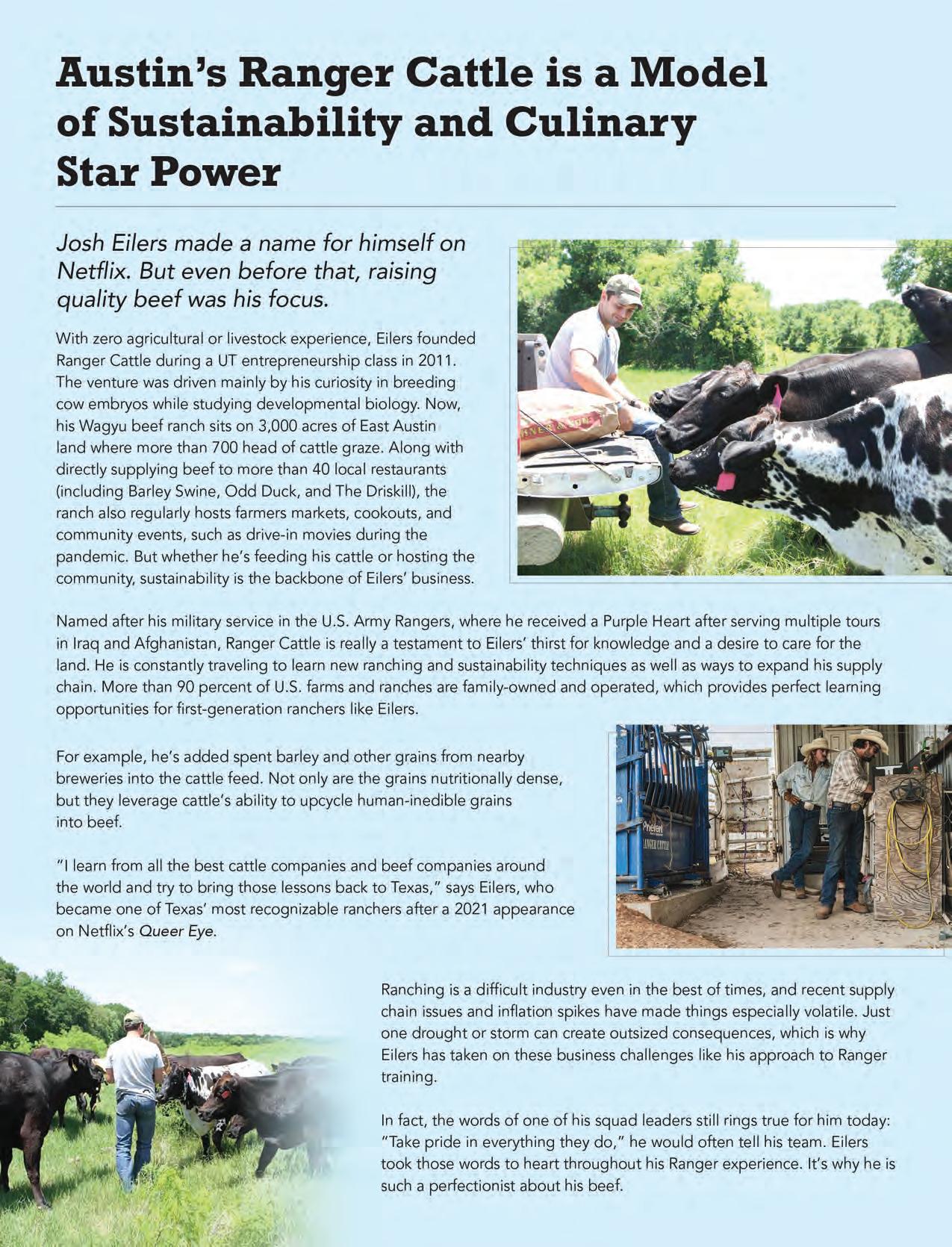

Whether you’re hopping
on a
plane or headed to the beach, these new books from local authors are the perfect summer companion.
BY MADELINE HOLLERN

Armadillos to Ziziphus: A Naturalist in the Texas Hill Country by David Hillis
As the director of the Biodiversity Center at UT, and a recipient of the MacArthur grant in molecular biology, David Hillis knows a thing or two about Texas flora and fauna. In his charming new primer on the region’s environment, the professor shares short essays paired with vivid photography on curious critters such as dung-rollers and Texas horned lizards, as well as little-known plants like the titular ziziphus (a spiny shrub, aka Lotebush).

The Donut Legion by Joe R. Lansdale
Nobody does noir quite like the bard of East Texas. A former Longhorn, Lansdale has a knack for tapping into the state’s zeitgeist, like in his latest standalone novel, which concerns a shady QAnon-style fringe group. When protagonist Charlie Garner goes in search of his missing ex-wife, he’s dragged into a world of donut shop fronts, UFO paranoia, killer chimps, and evangelical cults. It’s like Pynchon’s Inherent Vice behind the pine curtain.

His Majesty’s Airship: The Life and Tragic Death of the World’s Largest Flying Machine by S.C. Gwynne (May 2)
When pondering ill-fated airships, most think of the Hindenburg, which famously went down in flames in 1937. But seven years prior, the British airship R101 met an even deadlier fate, crashing and killing 48 passengers. In this historical tale, Gwynne recounts the rise and fall of the vessel and the doomed romance of Lord Christopher Thompson and his married lover, Princess Marthe Bibesco.

The Fight for Midnight by Dan Solomon (June 20)
A decade since Wendy Davis’ historic filibuster of abortion bill HB2, Dan Solomon re-imagines the event through the eyes of a teen. In this YA novel, the Texas Monthly writer follows Alex Collins, whose luck is about to change. After dealing with bullying and a community service sentence, he’s invited by the prettiest girl in school to protest the bill at the Capitol. Solomon’s debut deftly navigates themes like political tension and heartache as it chronicles that unforgettable day.

A Likeable Woman by May Cobb (July 11)
Don’t miss the latest thriller from the acclaimed author of The Hunting Wives. Her new book follows 30-something Kira, who returns to her hometown after her mother’s mysterious death. When Kira’s grandmother shares the unpublished, unfinished memoir of her mother, juicy secrets are revealed, fueling suspicions of murder. Having grown up in Longview, May Cobb knows how to capture the pressure-cooker environment of a small Texas town engulfed in scandal.



Whether it’s Caribbean cuisine (Canje) or a Basquestyle pintxo bar (Kalimotxo), the Emmer & Rye Hospitality Group always has an eye on seasonality first and foremost. The agriculture of the state helps drive their global mission, with the upshot of exposing many to the varied bounty of Central Texas. That’s never been more prevalent than with their latest, Ezov, which delves into the culinary history of northern Israel with ingredients like locally grown sorrel, horsemint, and Syrian oregano (one of the
key components in za’atar). Located on East Cesar Chavez Street, chef Berty Richter’s follow-up to TLV specifically looks at the culturally diverse Galilee region and its mix of Israeli and Arabic influences. For instance, mallow-based soups like molukhia and tahini-braised lamb koftas dressed in pomegranate seeds, dill, and the aforementioned Syrian oregano. “What really makes this food beautiful is the amount of ethnicities that have influenced the cuisine of the area,” Richter says. —Chris Hughes
Japanese cuisine discovers its south-of-theborder bonds at Ramen del Barrio.
BY CHRIS HUGHES
CHRISTOPHER KRINSKY MIGHT be early in his culinary career, but the 24-year-old Isla Mujeres transplant certainly knows his own palate: “I’m a glutton for heavy foods,” he admits. Plant-based, gluten-free, and every other wellness buzzword-of-the-moment hold zero appeal for the former Neighborhood Sushi chef, who cleared out his parents’ garage in December 2021 and started hosting ramen dinners that straddled the line between Mexican and Japanese street food. A few barstools and a couple makeshift tables turned into a viral pop-up and a waitlist that exceeded 300 every evening. Now, Krinsky has turned the concept into its own restaurant in Hana World Market. At Ramen del Barrio, he’s taking those early ideas even further as he stretches the bounds of the classic comfort dish into all manner of category-bending broths and bowls.

In Mexico, chocolatey mole is usually layered over braised chicken. The chef honors that poultry pairing by serving his freshly made iteration with fried chicken karaage. And the sauce itself is utilized in place of dipping broth in tsukemen, where chewy noodles are slurped up after being dunked in the liquid base.
Tare is the concentrated sauce that gives ramen such complex flavor. Instead of a typical soy- or miso-based version, Krinsky has created his own spin with guajillo, ancho, and arbol chiles, which he incorporates into tonkotsu broth. With the additions of tripe and hominy, it’s an ingenious fusion facsimile of the traditional hangover cure.


Forged from pig bones boiled for hours, creamy tonkotsu broth is an opaque homage to all things porcine. The same could be said for Mexican carnitas, typically whole hog cooked in lard. Krinsky marries the two by ladling the soup over confit buche and pork belly, as well as the aromatics from the carnitas oil (which contains orange juice, bay leaf, cola, and more).

From
Gen Z–approved merch
to brisket-topped everything, here are seven ways to create the next culinary hot spot in town.
BY CHRIS HUGHES

Half-dead succulents
Nothing goes better with those stained concrete floors and a vinyl bar than a menagerie of wilting succulents. They’re as funky and weird as the city (20 years ago). And nothing screams “Austin” more than ornamental plants native to South Africa and the Caribbean.
Don’t sweat the small stuff
Are you familiar with family-style dining? All good, because your servers are going to explain it regardless of the answer. The math is simple: Take the number of customers at any given table and multiply that by 13. Now, that’s the quantity of small plates the house suggests you order. The chef is from SoCal, and they swear it’s not “casual dining” without at least seven two-bite portions of ceviche and a $23 ramekin of guac.
Natural selection
Grape varietals, vintages, importers: All that stuffy minutiae doesn’t matter anymore. With natural wine, it’s all about drinking it for the ’gram. Whether selecting a chard or mourvedre, these rebel producers specialize in the same piquant aroma of dead yeast and battery acid. Just make sure the juice is cloudy and there’s graffiti art on the label (OMG, is that a tattooed pig with sunglasses?). Minimal-intervention wine is like flat brim caps and mom jeans: It’s a lifestyle.
Party in the back
Wait, is that the guy who ignores you at Stag Provisions? Why yes, he moonlights here as well, because Brazilian-leaning psychedelic synth-pop deejaying just doesn’t pay what it used to. Not to worry, though, he practices the same stellar brand of DIY service he’s honed folding Japanese denim. Overexertion kills the vibes, and by vibes we mean a carefully coiffed mullet (mustache optional) that corroborates a firm sense of irony.
Put a brisket on it!
Portland has a bird; we have slow-and-low beef. No matter the category, there’s no better way to give your menu some Texas twang than a juicy slice of brisket right on top. Tonkotsu ramen shop?
Brisket. Bakery? Sneak it into the chocolate chip cookies. German smorgasbord? You better believe that schnitzel’s been wellacquainted with a pit.
Get swaggy
If you forgot your flat brim or even a basketball jersey, don’t sweat it! Any restaurant worth their weight in social media clicks has got their own branded merch that taps into the Brooklyn streetwear aesthetic. Bonus: The font is the same one used on every natty wine label, so there’s no possibility of clashing on posts.
Do the tip flip
No more crunching numbers alongside the after-dinner mint because every business uses the same digital POS system that does it for you. And that number is much higher than you could’ve ever imagined. The good news is that your server will linger around the table, tablet on their palm, as diners attempt to complete the transaction. No pressure.
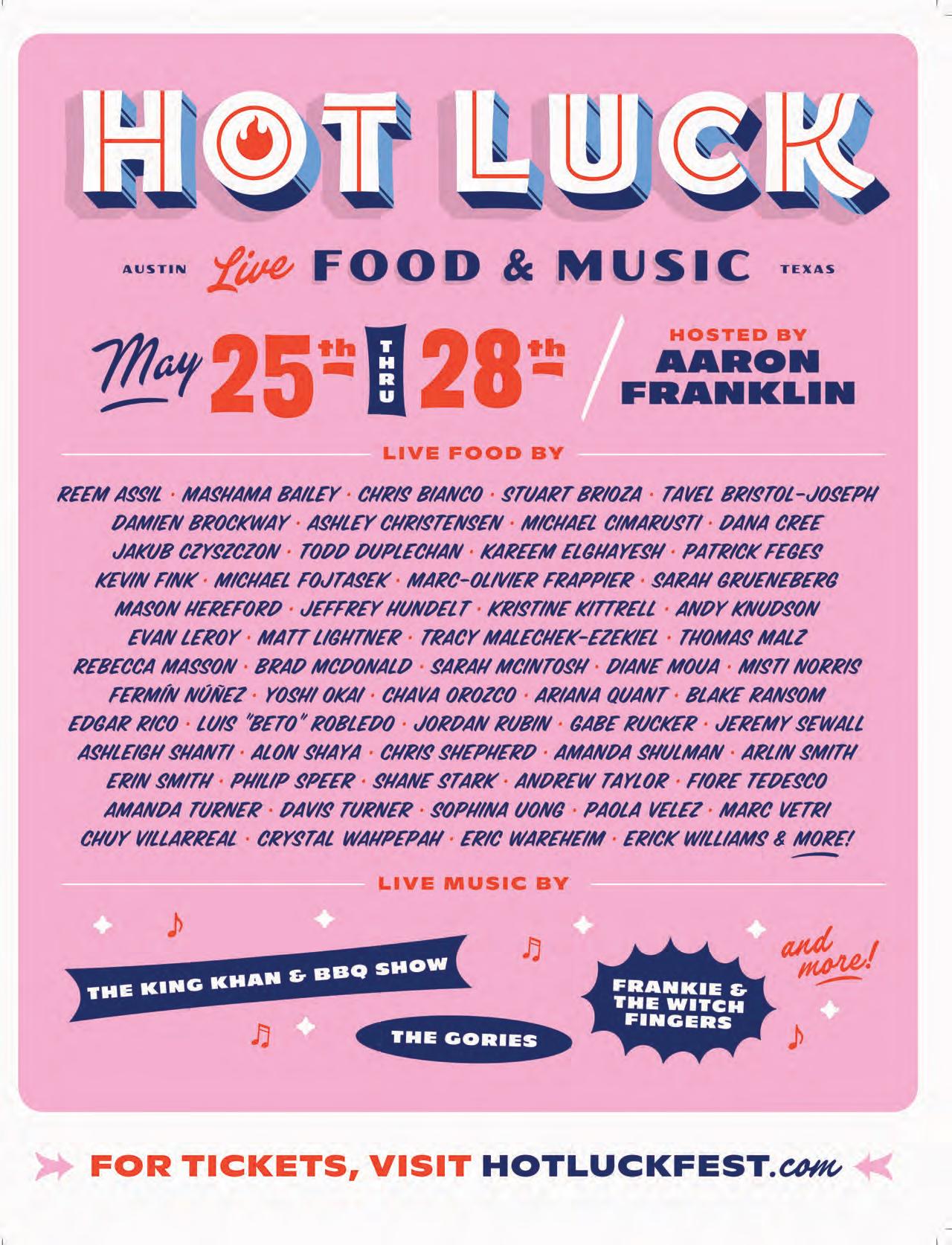
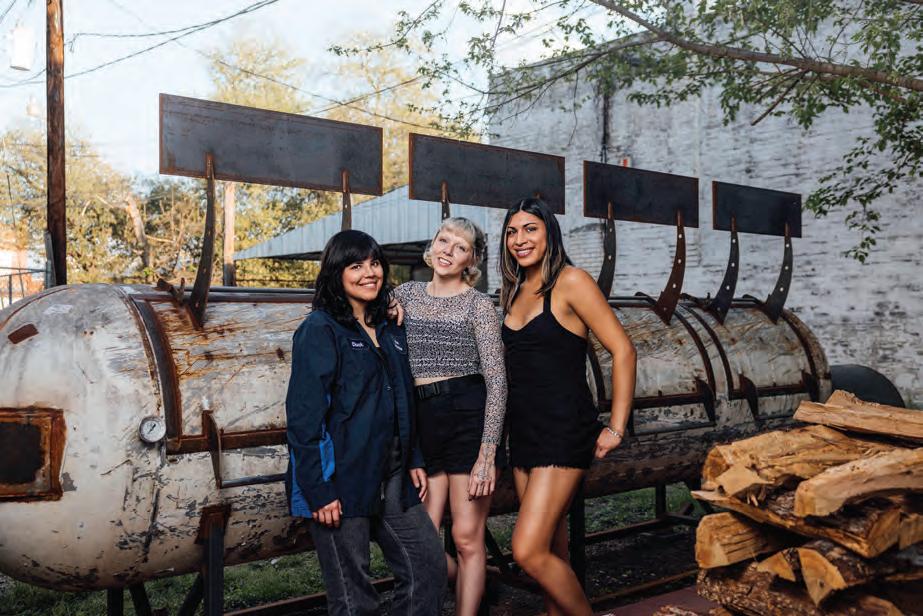
Barbs-B-Q in Lockhart is bringing all the smoke to the male-dominated world of ’cue one singular slice of brisket at a time. BY CHRIS
HUGHES
TO MAKE IT in Texas barbecue as a woman, you often have to go the extra mile. Or, in the case of Chuck Charnichart, roughly 7,200 miles.
In 2021, while on a three-month consulting gig at Longhorn Texas BBQ in Cairo, the 24-year-old pitmaster found herself working 16-hour days, pulling perfect briskets all while struggling to earn as much as her male counterparts. Each shift, as her Egyptian coworkers chafed at working under a female chef, she simply willed herself not to quit.
“In my mind I thought: ‘I need to get through this,’” she recalls. “It sucks, but as a woman, you do have to prove you can actually cook. Also, if I went home after a month, it’s going to be taken different than a man. They can bounce around and easily still find another barbecue job. For me, it would’ve taken another three years to get back to that position.”
These were hard lessons she learned from the outset, first working as a front-of-house employee at Franklin Barbecue, where she found little chance to move up—or back to the pit room, to be more specific. Then bouncing around between barbecue joints the world over, including her brief Arabian
excursion and one smokeless example in Oslo, Norway—all in search of opportunity. It wasn’t until Charnichart landed at Goldee’s in Fort Worth later in 2021, teaming back up with Franklin alum Jonny White, that she was embraced by a support system that offered change.
Not only was Charnichart part of the team that earned Goldee’s the No. 1 ranking on Texas Monthly’s vaunted list of the state’s best barbecue spots, but she was also afforded a platform to flaunt her own voice. While White and the other co-owners went on vacation in the summer of 2021, they handed over the keys to the restaurant so she could host pop-ups offering a more personal, Brownsville-tinged brand of smoked meats and sides. The budding pitmaster took advantage of an untapped pun and called it Barbs-B-Q, where she explored her youth growing up in Texas’ southernmost city. Brisket was dusted in a dry rub of Mexican spices, sausage was stuffed with chori-queso, and standard mac ‘n’ cheese was swapped out for green spaghetti, a Rio Grande Valley specialty made with cream cheese, milk, jalapeños, and roasted poblanos.
Joining her in the endeavor were Alexis Tovías Morales, Charnichart’s childhood friend from Brownsville, and Haley Conlin, a North Dakota native who’d also made her rounds in the Austin barbecue circuit. With only three weeks’ notice, the trio of reunited colleagues created a buzz that even surpassed the name on their employer’s marquee. The crowd that gathered that weekend in August prompted something much more than just a one-off spectacle, and soon, Barbs took to the road serving in places like Austin’s Nickel City and Best Little Wine & Books in Lockhart.
“Lockhart doesn’t know what’s coming.”
With the encouragement of White and the Goldee’s crew, Barbs began scouting a permanent home, but their respective residences across the state presented a geographic question mark. Would Charnichart stay in Fort Worth, where she’d finally busted through the creosote-stained glass ceiling that once shielded barbecue’s old boys’ club? Or head further south, where so many bad memories still lingered like the pungent aroma of post oak smoke after a 16-hour shift?
“Alex and Haley were still in Austin, and I wasn’t going to do it without them,” Charnichart says. “Austin didn’t really feel right, but I’d started going to Lockhart regularly for Mill Scale [the smoker brand] events over the past year. It was affordable, and there were all these small businesses cheering each other on. They were having a creative moment.”
After months of searching, Barbs-B-Q opens this spring on Market Street, right in the heart of Lockhart’s downtown square. In addition to many of the dishes seen at their pop-ups, they’ll be rounding out their menu with South Texas flavors like aguas frescas, cacti de gallo, handmade tortillas, and bread pudding transformed with a doughy base of vanilla conchas. Morales and Conlin are both former vegans, so they’re developing smoked meatless sausages and brisket—something they’ve been working on almost from the beginning. And the industry-disrupting tendencies don’t stop there.
In a field notorious for running employees into the ground, Barbs will only be open one day a week (Saturday). The rest of the time, they’ll be developing new menu items, producing videos on their popular YouTube channel, hosting how-to barbecue classes on the cooking and preparation of different meats, and lending out their restaurant for other up-and-coming chefs to host pop-ups. Inclusivity is also a major key, as they provide a safe space for Central Texas’ LGBTQ scene. A member of Austin’s trans community, Morales is in talks with House of Lepore and other queer artists to perform at Barbs. “Everyone can feel comfortable and come here as their own genuine selves, free from any judgy looks,” she says.
In a place that built its reputation on old school German meat markets established around the time of the Gunfight at the O.K. Corral, Barbs-B-Q represents radical change. This isn’t just another butcher paper joint in a small town drowning in shoulder clod and hot guts. Conlin admits that for every considerate show of online support, there’s another wishing they’d just open a Quizno’s instead. But for the rest of the community—and the barbecue-loving scene at-large—the future has never looked more enticing.
“Anyone who’s attended one of our pop-ups is always saying, ‘Lockhart doesn’t know what’s coming,’” Morales laughs. “I’d say we’re definitely spicing things up around here.”

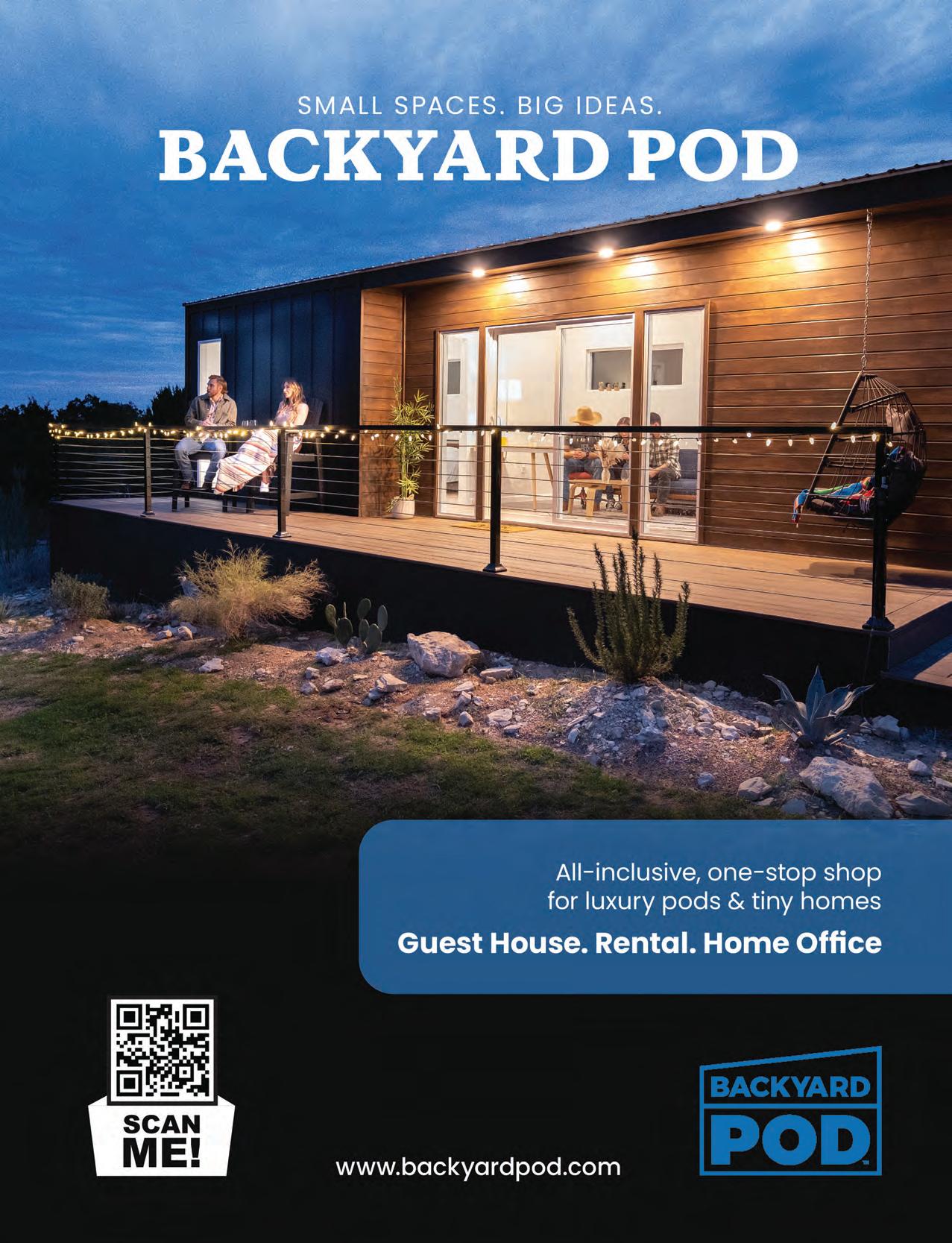
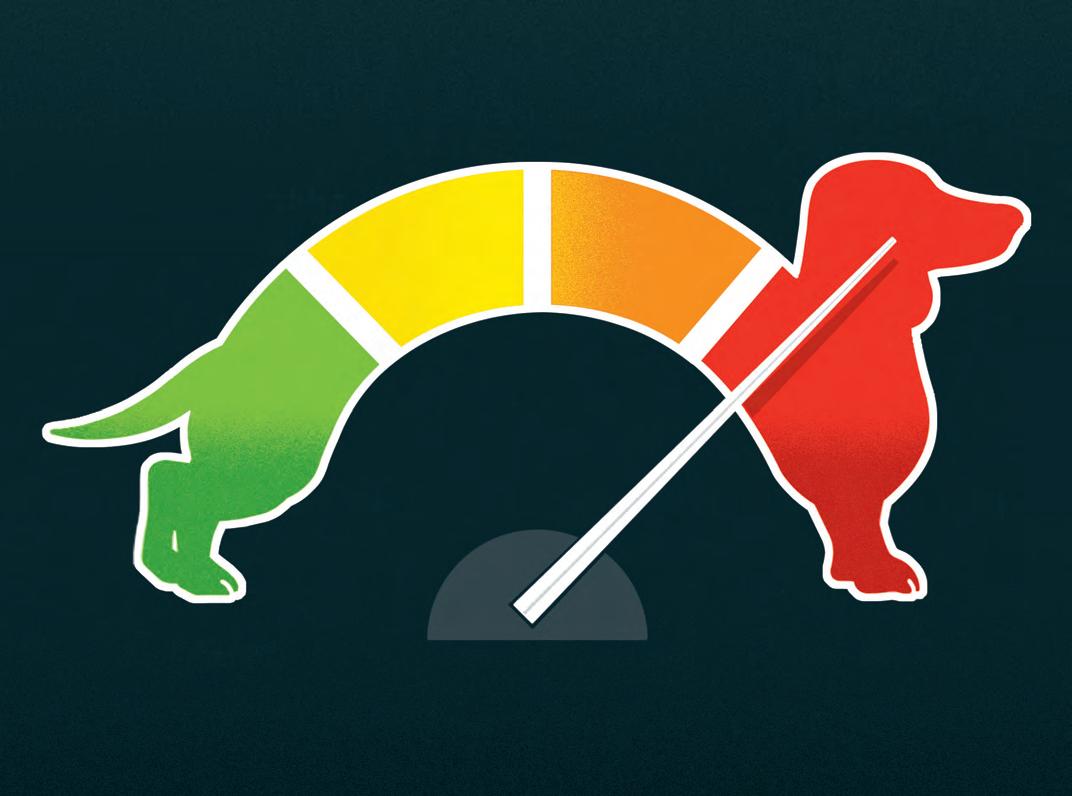
Austin’s no-kill policy for impounded animals has overburdened municipal facilities and created a crisis of abandoned pets flooding city streets, forcing citizens into action.
BY BRYAN C. PARKER

ON JAN. 20, Anjela Williams logged onto the Austin Lost and Found Pets Facebook page, where she’s become an active participant, and immediately came across a dire situation. Out in Del Valle, a dog showed up in someone’s backyard, and the landlord was threatening to shoot the animal if it wasn’t removed. Williams jumped in her car and sped to the house with plans to bring it to Austin Animal Center.
She managed to wrangle the frightened cattle dog mix into the passenger seat of her small, singlecab Mazda pick-up, but was told at the shelter that intake was full. More alarmingly, Williams was escorted to her car by a security officer after being given an appointment to return a month later. “I was treated like a criminal, and I was just trying to help,” she says. Wiping away tears and feeling helpless, Williams reluctantly took the 50-pound dog back to her one-bedroom apartment, joining many concerned residents who have found themselves in similar situations.
Austin has led the charge in becoming the largest no-kill city in the country, a status held since March 2010. But that idealistic goal has also created some logistical challenges—most notably, the cityrun Austin Animal Center has operated at or over capacity for months, with little indication that will change soon. In 2022, AAC took in 12,696 animals, dramatically fewer than the 19,312 animals in 2019. Yet an intake status indicator on the shelter’s website remains permanently stuck to the far right in a red zone. Captioned beneath it: Emergencies only. Restricting intake (along with a stalwart protocol to spay, neuter, and microchip pets) has allowed the shelter to maintain an impressive live release rate—97.3 percent in 2022, its highest to date. A city must maintain a 90 percent live release rate to be considered no-kill. By comparison, Houston and Dallas both narrowly passed that threshold amid the pandemic as adoptions spiked, but those rates have dwindled to the mid or low 80s in recent months, dreadfully short of the no-kill status.
Dr. Ellen Jefferson poses with her dog, Echo, whom she rescued and helped overcome distemper.
Austin’s shelters handle a mastiffsized workload.
10,533
Adoptions completed by Austin Pets Alive! in 2022.
1 in 5
Approximate number of American households that acquired a pet during the pandemic.
24%
Portion of animal intakes that are owner surrendered to Austin Animal Center.
5,736
Animals spayed and neutered at Austin Animal Center in 2022, helping to reduce the proliferation of the stray population.
32,563
Total calls received by Austin Animal Protection last year.
To explain AAC’s intake restrictions, Chief of Animal Services Don Bland says, “Adoptions nationwide have dropped, and it’s affecting us as well.” Austin’s increasing cost of living is partly to blame for a decline from around 8,700 adopted animals in 2019 to around 7,100 last year. Bland points not only to the expense of caring for a pet but also the trend of landlords charging higher pet deposits or even a recurring monthly fee. To make matters worse, a rush of pandemic pet adoptions boomeranged as animals were returned to shelters en masse.
One of the pioneers of the no-kill movement in Austin, Dr. Ellen Jefferson, is the president of Austin Pets Alive! and founder of Emancipet, which offers low- or no-cost veterinary care to pets. While praising the hard work of city facilities, she feels that more progressive methods could be used to increase adoptions and break the entrenched mindsets of how shelters function. “We are taking in as many animals as the City of Austin, but we have invested in a massive foster program,” Jefferson says. “A foster home is better than a kennel for the animal’s quality of life and for us to make them more adoptable in the long run.”
As of February 2023, Austin Pets Alive! had approximately 247 dogs on-site in their shelter with more than 1,000 in foster homes, a strategy that decreases the necessary amount of centralized space and labor required to care for animals. By comparison, AAC housed slightly fewer than 500 dogs in their facilities and had less than 300 in foster situations.
And that’s not the only alternative approach Austin Pets Alive! has in mind. The nonprofit has spearheaded area-wide adoption events with neighboring cities and counties, piloted a program to hire school-age youth to learn about animal care, and manages the P.A.S.S. Facebook page with resources for positive alternatives to shelter surrender. The organization also hired a social worker who conducts compassion fatigue training.
That last part feels crucial when considering the situation Williams found herself facing in January. She remembers thinking that even if AAC had no space for the animal, the employees who assisted her could have shown more empathy. Likely, those involved in the care of animals possess tremendous compassion, but that gets depleted by handling one crisis after another involving distressed pets and their human owners.
One thing Jefferson and Bland agree on is that municipal shelters have historically existed solely to capture stray animals and euthanize them. Flipping that script is no small task, and substantial action is needed to accomplish these modern goals. Revamping the current facility, increasing funding, and even adding a second location could help alleviate the problems, according to Bland. He also notes that steps have been taken for increased aid, such as Councilmember Mackenzie Kelly earmarking funds to hire a certified behaviorist for the shelter, and some general support from Councilmember José Vela. Though it would further the cause if more councilmembers adopt this as a pet issue (ahem…).
As it stands, people like Anjela Williams have been forced to take matters into their own hands. With the help of friends from the Lost and Found Pets page, she rehomed the dog unwillingly acquired out in Del Valle. But this job should not fall on the shoulders of private citizens. Austin has achieved laudable goals, but if the city wants to fulfill to its lofty no-kill aims, permanent intake restriction isn’t an option. City leadership will need to pony-up the resources necessary to make the program worthy of being called best in show.


The mere mention of Laurie Gallardo’s name conjures the longtime deejay’s effortless cadence as she introduces a song by your new favorite band. After joining KUT parttime in 2003 with a 6 a.m. slot on Sundays, she helped launch its music-focused spinoff station, KUTX, which turned 10 in January. In her two decades as a host on Central Texas airwaves, Gallardo has received the Austin Music Award for Best Radio Personality seven times running and was recently inducted into the Austin Music Hall of Fame—apt accolades for a voice synonymous with music in the capital city. INTERVIEW BY
BRYAN C. PARKER
What early experiences solidified your love of music?
My parents and their tastes, which ran the gamut. I remember my dad one moment listening to some old soul, and the next minute it would be Johnny Cash. A lot of soul, a lot of R&B, a lot of radio. I was definitely a radio kid, and I was a pest. I would call the deejays all the time. So, I think when people try to reach me on the phone, it’s revenge.
When did you know that your voice was something special?
I would be goofing around in school— and I could be a class clown—and a couple of my teachers would remark, “You know, you really present yourself in this way. There’s a certain thing about the way you talk.” And it was always highly complimentary. I didn’t really understand. I was just being goofy and showing off. But when I began to take speech courses and a little bit of theater in high school, I was like, OK, this is it.
Who were the personalities or mentors that shaped your affinity for this medium?
A lot of the deejays that I grew up listening to in El Paso. Steve Crosno had been doing it for years. He’s since passed away. He was the nicest human being that you could possibly meet and always the consummate profes-
sional. As I got a little bit older—I cannot remember her last name—but her first name was Libby, and she kind of looked like Stevie Nicks, and she was very patient with young people like myself. Whenever I would call in, I would just be going nuts, because I loved her delivery. She sounded so laid-back, and she was funny.
KUTX turns 10 this year. What does it feel like to be such a defining part of a station from its inception?
I could feel the excitement that was palpable, but really to me it was making a natural progression. KUT is such an extraordinary entity. You do not really find a lot of public radio stations like this. And the fact that it was able to do both news and music—and the kinds of music that it was doing is just mind-blowing. I’m really proud because everyone brought something. And look at us 10 years later—I’m really impressed.
What’s something wild or funny that you remember behind the scenes of the radio magic?
One SXSW, NPR allowed Nick Cave to be broadcast live at Stubb’s. I remember our CEO was looking at me: “Why are you shaking your head no?” And I said, “It’s Nick Cave. He is going to do this one song.” And I was thinking of “Stagger Lee.” I was in the
studio that night, and it came to the very song that I’m talking about. And every other word was an F-bomb. When you look at the operations board, there’s something that’s called the dump button. That’s the thing that you press to delay sound if someone says a curse word or whatever. I stepped away and said, NPR, this is your problem and not mine. I just wiped my hands. I turned it up loud. I was practically alone at the station. It was just incredible to hear “Stagger Lee” over these wonderful speakers and not do a damn thing about it.
You’ve pointed out that Teresa Ferguson started Austin Music Minute, but you made it your own. How did you pull that off? In the beginning, I didn’t want to inherit it. That was Teresa, and she was the one who encouraged me to make it my own. She gave me a basic outline to work with, which I still use to this day. She was the one who reinforced the belief that you just have to make it the way you sound. It was a painful transition, but one of our now-retired producers, David, was like: “You also need to learn to do some editing.” I’m so eternally grateful that I learned how to do that. And a lot of people don’t know that about the Austin Music Minute. What you hear is what I’ve put together with all of my editing and production work.
How does it feel to become such a recognizable voice of Austin? Overwhelming. I’ve just never really seen myself as an ambassador, but I am happily taking on the role. We truly do have an international audience. Not only are people in Austin listening, but we have listeners worldwide because you get to stream it on your computer, on your laptop, as an app. The most fulfilling part is sharing the music. I am a glorified messenger, and I wish I could explain to people how much I deeply appreciate the fact that they think I’m something special. There are all ears and all eyes on our city. We have an embarrassment of riches. You’re like, Hey, Austin, hell yeah. That’s where I’m from
If you could give your younger radio-listening-self one piece of advice, what would you say? It’s going to be a hell of a lot better than you realize, and I’m so proud of you.
This interview has been edited for clarity and length.
An innovative new freight truck company in Austin is cementing the city’s reputation as the capital of driverless technology. BY
WHEN YOU THINK of electric vehicles in Texas, Tesla may be the first company that springs to mind. But Swedish company Einride, which has developed a line of autonomous electric freight trucks, branched out into North America in 2021 with a center of operations here in Austin. The growing team of engineers includes North American manager Niklas Reinedahl, who touts Einride’s plans to “disrupt the freight mobility market.” The company has already deployed autonomous trucks in General Electric Appliance’s sprawling business park in Tennessee and even on adjacent public roads as operators in Austin oversee the vehicles and address any problems remotely. Now, they hope to grow their fleet into the thousands over the next decade. Here, the facts and figures behind their ambitious venture.
BRYAN C. PARKER
$2.7 trillion
The total value of the global trucking industry as of 2021. Freight is among the largest industries in the world, which has made it slow to change and ripe for a market shake-up.

8%
Portion of the total amount of global greenhouse gas emissions generated by the freight industry.
2.2 BILLION TONNES
The amount of CO2 emissions from road freight in 2021.
Einride hopes to change these figures drastically, not only by decarbonizing the industry with electric vehicles but also by increasing the efficiency of trucks on roads through an advanced, algorithmdriven digital platform called Saga.
THE APPROXIMATE WEIGHT OF ONE OF EINRIDE’S FULLY LOADED CLASS 8 FREIGHT TRUCKS. = 10 MILLION
$650 MILLION
The amount of investment capital secured by Einride, as venture capitalists bet big on changes to an antiquated industry.

2.9 MILLION
Number of tractor trailer trucks operating on U.S. roads in 2020.








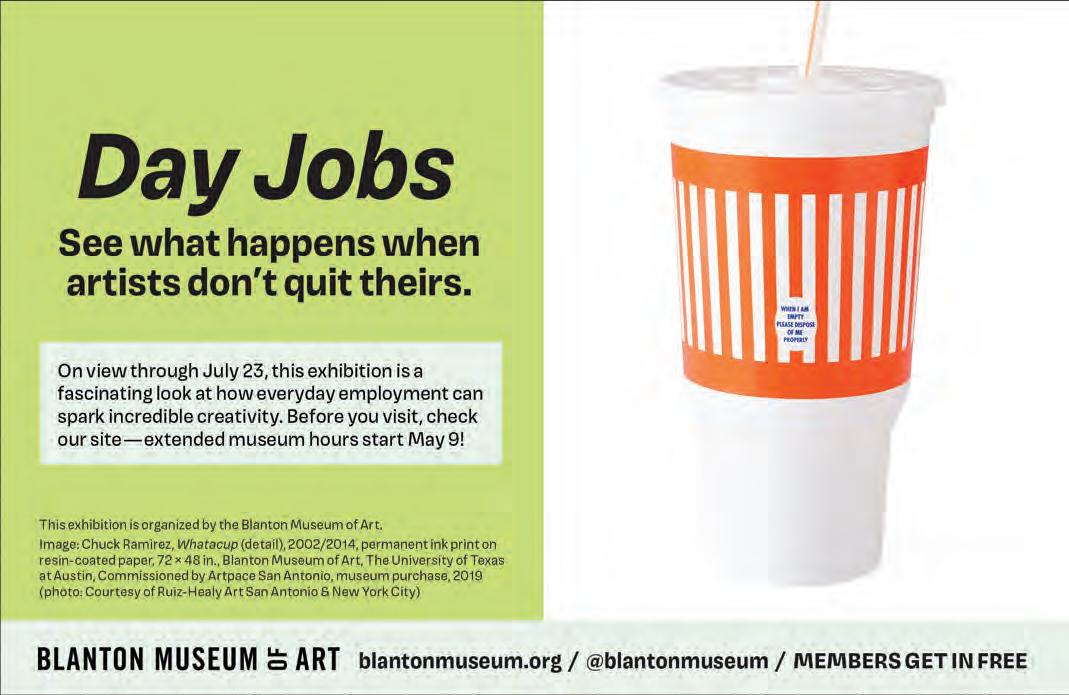

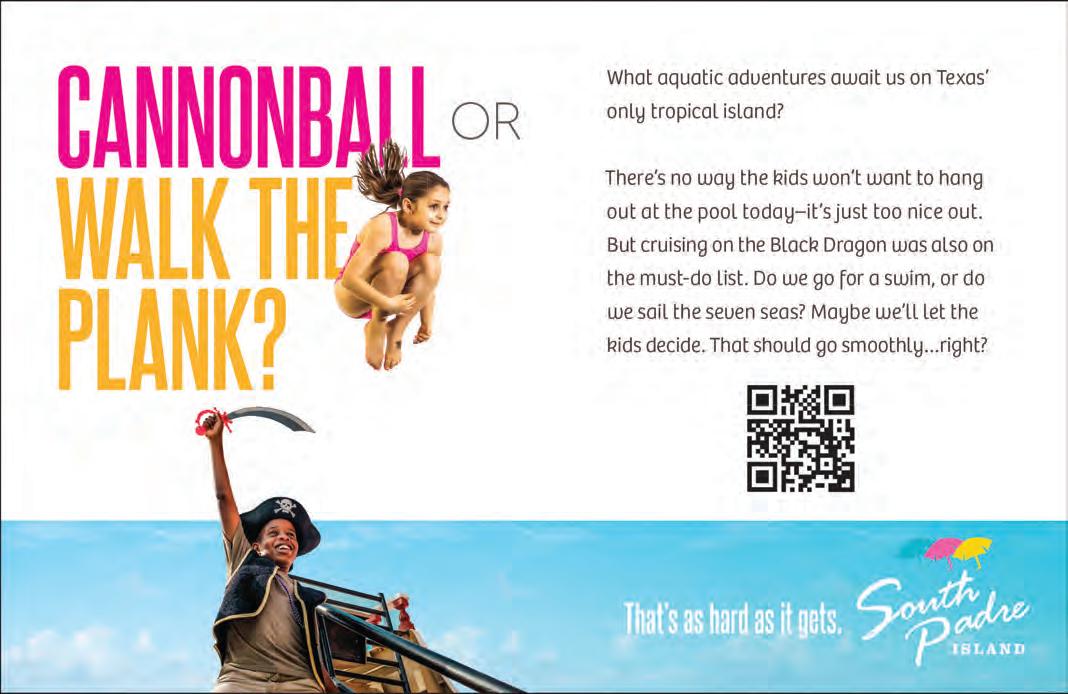


When temperatures reach triple digits, one thing is certain: You need to make a splash. In this comprehensive guide to all things aquatic, we highlight the best beaches and scuba spots, test out the cold plunge craze, and help you choose your next water park adventure. Because in the Lone Star State, darling, it’s always better down where it’s wetter!


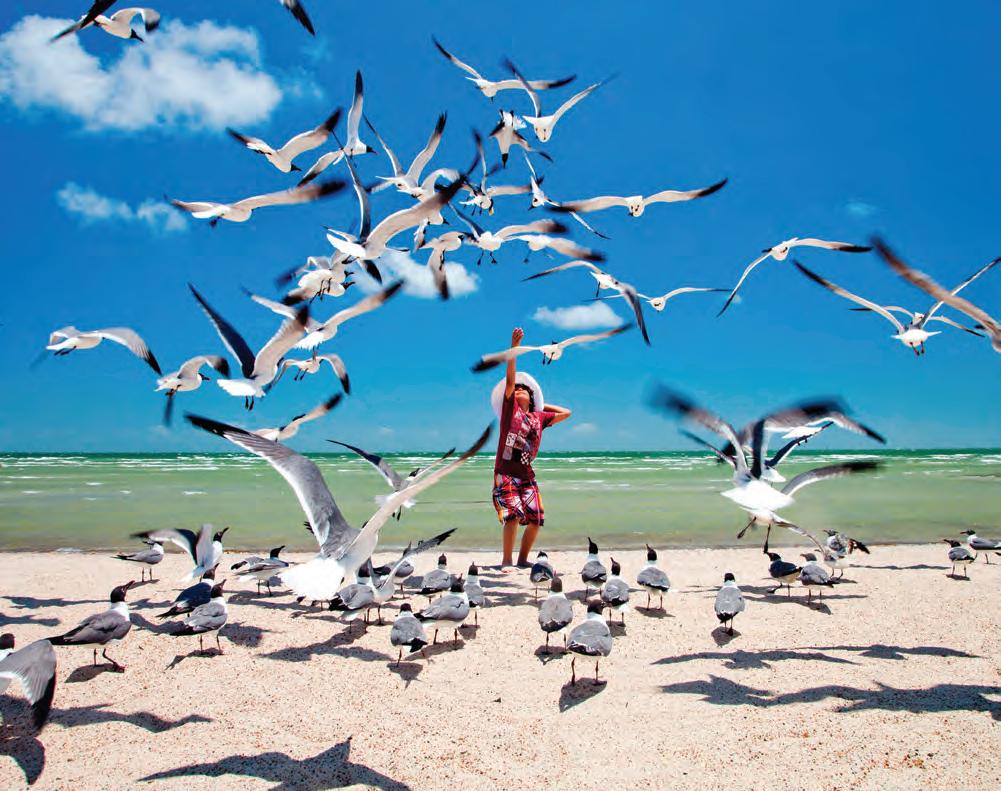
Dip your toes in the sand at these 6 sun-kissed Texas beaches.
Delightfully frozen in time, the quaint fishing town of Rockport is one of Texas’ cleanest coastal destinations. The crescent-shaped strip along Aransas Bay boasts shallow waters and safe swimming away from the constant waves and riptides encountered on the barrier islands. Visitors seek out Matagorda and Copano Bay for some of the best wetland fishing on the Gulf Coast.
Once defined by its roving wild horses and masses of migratory birds, Mustang Island ranks among the most idyllic stretches of coastline in Texas. Explore the island via dozens of access points across its 18 miles: On the Lively Beach side near Corpus Christi, you’ll find a surfer’s paradise, campground, and after-work tailgate heaven, while the Port Aransas Beach end features seaside restaurants and kitschy bars.
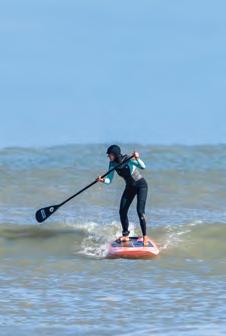

Head 25 miles east of Brownsville to discover Texas’ final 8-mile stretch of beach, which ends at the Mexico border. Before SpaceX built its launch site just inland, Boca Chica was at least an hour from any human activity. Today, it’s still a quiet, free camping destination for snorkeling, surf-fishing, and swimming—unless the beach is closed for scheduled rocket launches or tests. With no stores nearby, prepare to pack all your camping or beach-day essentials before you go.
When visitors come to this untouched expanse of coastline, they know they must defer to Mother Nature. Here, endangered species like Kemp's ridley sea turtles are safe to nest their eggs, and the island safeguards feeding and breeding grounds for more than 380 birds, including black-capped vireos and cerulean warblers. Traverse the island (quietly!) via its boat launch, nature trail, or miles of peaceful beach camping.
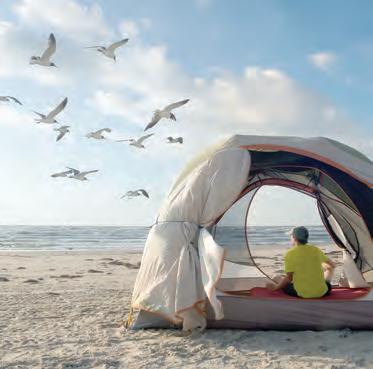
Just as its name suggests, this area near Freeport on Folett’s Island has ideal waves for surfers, windsurfers, and kiteboarders. While the beach gets busy in the summer months, the oceanside town becomes a quiet horseback destination in the offseason. Stroll through its Surfside Bird and Butterfly walking trail or take a short drive to the Brazoria National Wildlife refuge for prime bird and wildlife watching, hunting, and fishing (permit required).
Less than a 20-minute ferry ride from Galveston, Crystal Beach rests on the Bolivar Peninsula. Blue, yellow, pink, and turquoise vacation homes offer beautiful, prime oceanfront getaways in this mellow Gulf Coast town. Savor fisherman’s platters and live music at popular restaurants like the Stingaree and HardHeads IceHouse. Visitors who want to rough it a bit are welcome to drive onto the beach, pitch a tent, and sleep under the stars (parking permits required).
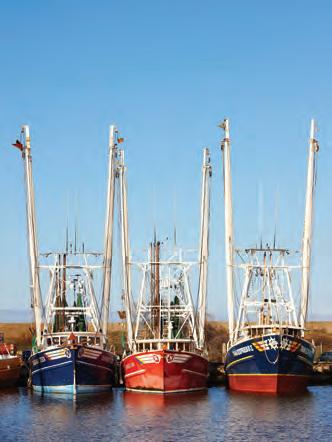
Refuel at these classic seafood shacks along the Gulf Coast.
When you’re ravenous after a busy day at the beach, you need a laid-back spot that will accommodate flip-flops and a sodden coverup. Cap off a visit to the Galveston shore with a stop at 79-year-old Sonny’s Place, home of the Artery Clogger (a chicken-fried steak with bacon, two types of cheese, and ranch dressing) and Grandma Theresa’s famous gumbo (available Fridays only). In Rockport, visitors love to get their hands dirty at The Boiling Pot , where servers line the tables with butcher paper before a dramatic bucket dump of your spicy seafood boil of choice. And no trip to Corpus Christi would be complete without a trip to Snoopy’s . After chowing down on fried black drum sticks, walk next door for a cone of Blue Bell at its adorable sister shop, Scoopy’s galveston.com/ sonnys; theboilingpotrockport.com; snoopys.cc

WHEN I READ about the new “cold plunge” craze, I shuddered in horror. My favorite thing to do is read under a cozy blanket, so the idea of voluntarily immersing myself in icy water sounded like a nightmare. Yet as friends old and young began promising that these frigid dips made them feel euphoric and could help to manage anxiety and depression, I grew intrigued. If begrudgingly.
Though the practice is all the rage right now, cold water therapy is nothing new: From its use by Ancient Romans and Native Americans to the “water cures” of the 18th and 19th centuries, these plunges have long been touted as a means to alleviate mental and physical pain. They can increase dopamine, reduce muscle inflammation, improve immunity, and some claim facilitate weight loss by boosting metabolism.

Here in Central Texas, the Comanches once soaked in our own Lake Austin, so I decided to follow suit. In chilly February, I headed to luxurious Lake Austin Spa Resort for a “Cold Water Immersion,” one of the spa’s new “Wild Water Wellness” offerings. I arrived the night before my plunge to prepare myself by watching 90-Day Fiancé UK from an impossibly soft king-sized bed and ordering both desserts from executive chef Stéphane Beaucamp’s dinner menu. (Lemon tart and chocolate-pistachio cake—how could I possibly choose just one?)
In the morning, as mist rose above the lake, I donned a swimsuit and slowly walked to the boat

dock. Lake supervisor Kamryn Hendrix explained that for the first 30 seconds, my nervous system would be activated and my mind would be in “chaos.” However, if I breathed through this discomfort and remained still, I’d reap myriad benefits.
Hendrix and the resort’s director of wellness, Cindy Present, joined me as I jumped in the lake, which ranges in temperature from 52 to 60 degrees. As promised, the second I went underwater, my brain went haywire. I gasped for breath, almost in shock. The water felt like knives on my skin, and my hands and feet began to ache painfully. Hendrix and Present guided me through deep breathing. About a minute later (or maybe it was three seconds—time seemed to stand still), as I opened my eyes and unclenched my fists, green hills came into view. I noticed the coos of doves and chirping robins. I felt tranquil. As my body warmed back up, I took a hot cup of tea and a journal to sit for a moment, lost with my thoughts. I felt more present, able to keep my To-Do list at bay and savor my tea as I gazed at the water.
Returning home, I’ve found a new appreciation for the practice. Instead of reading indoors like I do most summers, I’m inspired to head to one of our chilly, spring-fed swimming holes, jump in, and force my mind to endure the 30 seconds of turmoil. It’s worth the serenity that comes afterward—not to mention the enveloping warmth of the Austin sunshine. lakeaustinsparesort.com
Want to do something cool with a couple of party animals? At Blue Hills Ranch in McGregor, Texas, guests can book the “Otter Adventure,” a chance to swim with the resort’s two Asian small-clawed otters. Splash around with Otto and Sweet Pea as you feed them fish popsicles and shrimp treats in a private hot tub. 2 to 6 people, 12 years or older, bluehillsranch.com
Howler Brothers co-founder Chase Heard shares his favorite waterways, tips, and gear for Texas angling.

TOP SPOTS
“As far as proximity to Austin, it’s hard to beat a float down the Lower Colorado River. If you’re up for traveling a little, the Llano River in springtime is absolutely remarkable. If you’re willing to go even farther, exploring the Devils River in South Texas is an amazing experience: It’s a crown jewel of the state and still one of the most remote places I’ve ever fished. Personally, though, my favorite option is to head for the saltwater. There is just such a vast array of wildlife on the Texas coast, and the fishing is some of the best on the Gulf.”
TYPES OF FISH
“The coolest fish for me is our state fish, the Guadalupe bass —it’s only found here in Texas! On the coast, redfish pretty much dominate everyone’s focus, but there is a small window for Tarpon fishing as well.”
OPTIMAL TIMES
“Even in May, it doesn’t take long for the temperature to start climbing. So, the best time of day to go fishing is early morning or just at sunset . Both times are magical in their own right.”
ESSENTIAL GEAR
“You need a good cooler for your lunch and cold beer, so I usually grab my YETI Hopper. Good-polarized sunglasses like Smith’s are a must as well. Our Howler Brothers Loggerhead Hoodie is the ultimate sun shirt for fishing, whether on the river or at the coast. If my day is going to be spent on a boat, I will bring along a Turtlebox speaker so we always have good tunes (no matter how the fishing turns out).”
BEST BAIT
“Most of the time I am fly-fishing, so it really comes down to matching your fly to what the fish are eating at that time and place. My favorites on the coast are light-colored shrimp patterns . The flies are just so cool and realistic looking—very natural in that habitat.”



ANIMAL PLANET Some things just get better with age. As part of the Houston Zoo’s centennial campaign, “Keeping Our World Wild”—a six-year project to revitalize the 55-acre site in honor of its 100th anniversary in 2022—the Bayou City destination debuted one of its most-anticipated additions this spring. Featuring a 270,000-gallon One Ocean aquarium at its center, the expansive new Galápagos Islands exhibition is home to giant Galápagos tortoises, black-tip reef and bonnethead sharks, sea lions, and a colony of Humboldt penguins. Just as the oceanic archipelago once influenced Charles Darwin to create his theory of evolution, it’s now inspiring the zoo’s conservation efforts against the devastating impacts of global climate change. houstonzoo.org

Do you prefer a day trip or overnight stay?
Are you more into thrill or chill?
Would you brave a water ride with an inversion?
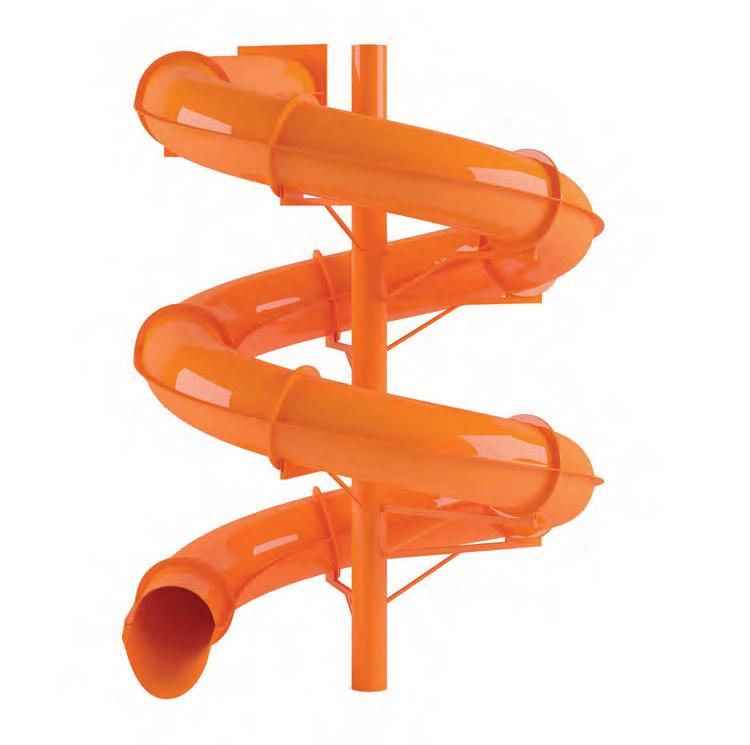
Are you bringing kids with you?
You’ll flip—literally!— for the Pirate’s Plunge experience at this Wichita Falls park. The water slide starts with a 37-foot vertical drop before launching riders on a 360degree loop.
Head to Arlington to test your mettle inside pitch-black slides, zero-gravity tunnels, and the Mega Wedgie, an 83-foot-tall half pipe experience not for the faint of heart.
Less than a 90minute drive from Austin, this theme park is full of heartpounding water rides, including its new Catapult Falls flume coaster, featuring the world’s steepest flume drop.

No need for sunblock at Round Rock’s 223,000-square-foot indoor water park. The little ones will love the diminutive lazy river and mini slides at its kidcentric Tiko’s Watering Hole.
If you’re traveling to South Padre Island, don’t miss the interactive water funhouse at this park’s Sand Castle Cove, named one of the Top 5 Kid’s Water Attractions in the U.S. by USA Today
Schlitterbahn
Spend a day with your pals floating on the lazy river, lounging in a rented poolside cabana, and sipping cocktails from one of several swim-up bars at this classic New Braunfels destination.

Beyond Hamilton Pool, here are 3 more incredible cascades across the state.
A 2.8-mile round-trip trail begins on an arid dirt path before descending into a Jurassic-like gorge that leads to Gorman Falls, featuring 65 feet of flowing waterfalls.
After heavy rain, a 40-foot veil-like waterfall drapes into a deep aqua grotto, creating a hidden paradise. (Take note: The preserve is on private property, so guests must book a two-hour guided tour to access it.)
Most of the year, visitors only see trickles of water down the rock face, but this outdoor adventurers’ paradise is typically in its full glory in the summer rainy season.



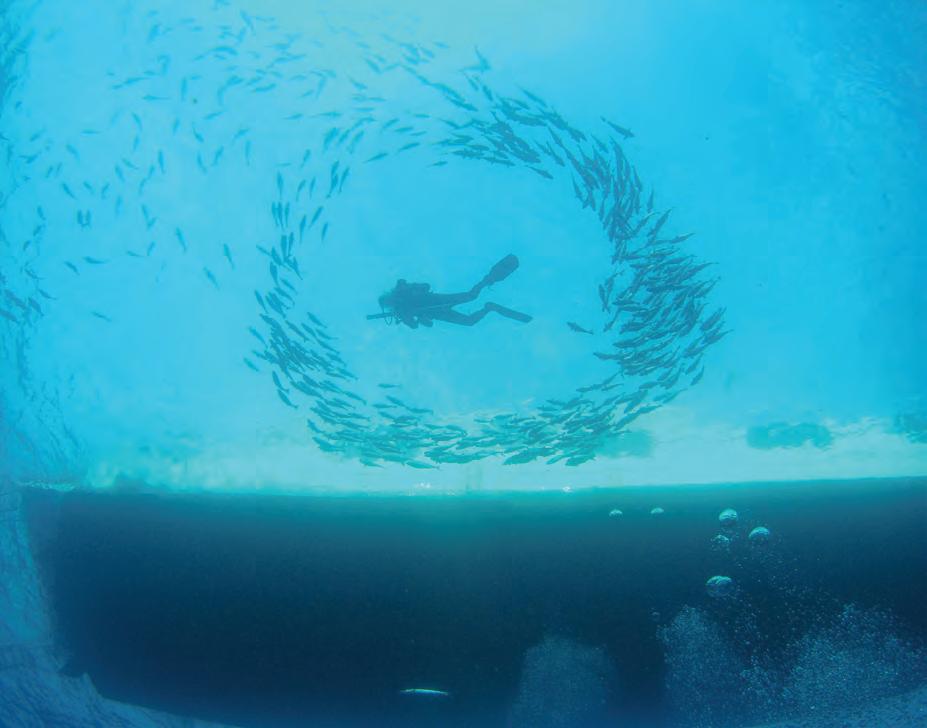
Discover everything from shipwrecks to nuclearproofed 1960s offices at these subaqueous spots.
CURIOUS ABOUT WHAT lies beneath? As hot summer days approach, local shops like Tom’s Dive & Swim can prepare you for underwater adventures in Texas. Once you’ve become PADI certified—a pre-requisite for scuba diving—join a group such as the Austin Aquanauts or sink into the cool depths with a certified dive master. In West Texas, San Solomon Springs in Balmorhea State Park is a great dive for beginners (and snorkelers and swimmers alike). Three-and-a-half million gallons of 72- to 76-degree water await you on even the sultriest days. At Quarry Lake at Reveille Peak Ranch , guests can swim with bass and catfish. The lake has visibility of up to 20 feet, and its graphite shimmers when illuminated with dive lights. For those who seek sunken treasure, a WWII troop transport and attack ship called the Texas Clipper can be visited off the coast of South Padre Island. The wreck, which lies on her port side, is alive with coral, barnacles,
octopus, and fish. Off the coast of Galveston, the Flower Garden Banks National Marine Sanctuary is accessed via a liveaboard vessel called the M-V Fling. From Freeport, the ship heads out for a weekend or longer. (Divers sleep in cozy bunks and share meals and scuba stories.) The area is also known for vibrant reefs and hammerhead and whale shark sightings when in season.
But the most brave, advanced divers whisper about Dive Valhalla, a flooded Atlas missile silo outside of Abilene. During the Cold War, the silo was built to withstand a nuclear attack. Divers descend five flights of stairs and enter through solid steel blast doors, then submerge into 60-degree water 130 feet deep. Prepare to be enthralled by the abandoned spaces, which hold everything from Mad Men–era furniture to a control room and a platform that once held a navigation system capable of aiming and locking a ballistic missile. —Amanda Eyre Ward
Slated to open in early summer, this reimagined seaside motor court in Galveston is primed to become the buzziest vacation spot on the coast. The Boulevard hotel features design by Austin’s Kartwheel Studio and a food and beverage program from Houston’s Justin Yu (Oxheart) and Bobby Heugel (Anvil). Enjoy the French-meets-coastal-inspired cuisine at its restaurant, The Fancy, and grab an après-swim cocktail on the rooftop overlooking the ocean. hotellucine.com


From a durable boat cooler to a float guaranteed to be the hit of your next pool party, these essentials will help you dive into the season in style.

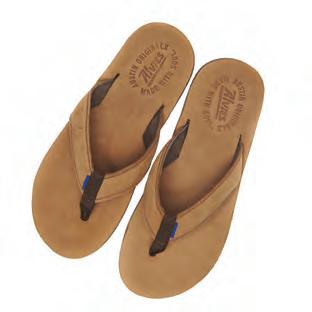



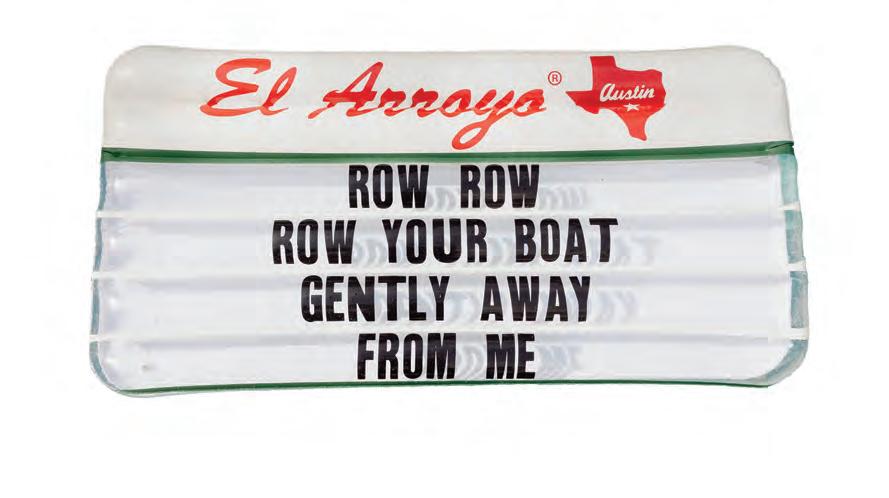
1 The Austin eatery’s famous sign now doubles as a sassy inflatable lounger.
El Arroyo Pool Float – Row Away ($42) at elarroyo.com
2 Avoid harmful UV rays on your road trip to the coast.
The Skinny Confidential Bougie Driving Gloves ($35) at shopskinnyconfidential .com
3 Shield your eyes from the Texas sun with one of these handy fishing hats. TX Fly Co. Guad Bass Cap ($25) at txflyco.com

4 These ultra-flattering, vintage-inspired swimsuits are perfect for a day at the pool.
93 Play Street Piper Bubble Blue 80s Cut High Leg One-Piece ($110) at 93playstreet.com
5 Hang ten—or train for your next triathlon—with Roka’s versatile new wetsuits.
Roka Men’s Maverick Wetsuit ($295) at roka.com
6 This stylish 100 percent Ethiopian cotton beach towel is the ideal sand repellent.

Raven + Lily Alem Towel in Mulberry ($75) at ravenandlily.com
7 These sturdy sandals will last you well past those triple-digit days. Alvies The Riverside Men’s Flip-Flops in San Marcos Suntan ($75) at alvies.com
8 This portable cooler will keep your refreshments icy cold during your lake excursion.
YETI Roadie 48 Wheeled Cooler in Charcoal ($450) at yeti.com

From breathtaking paddleboard excursions to glowin-the-dark kayak tours, here are 5 water-centric activities throughout Texas.
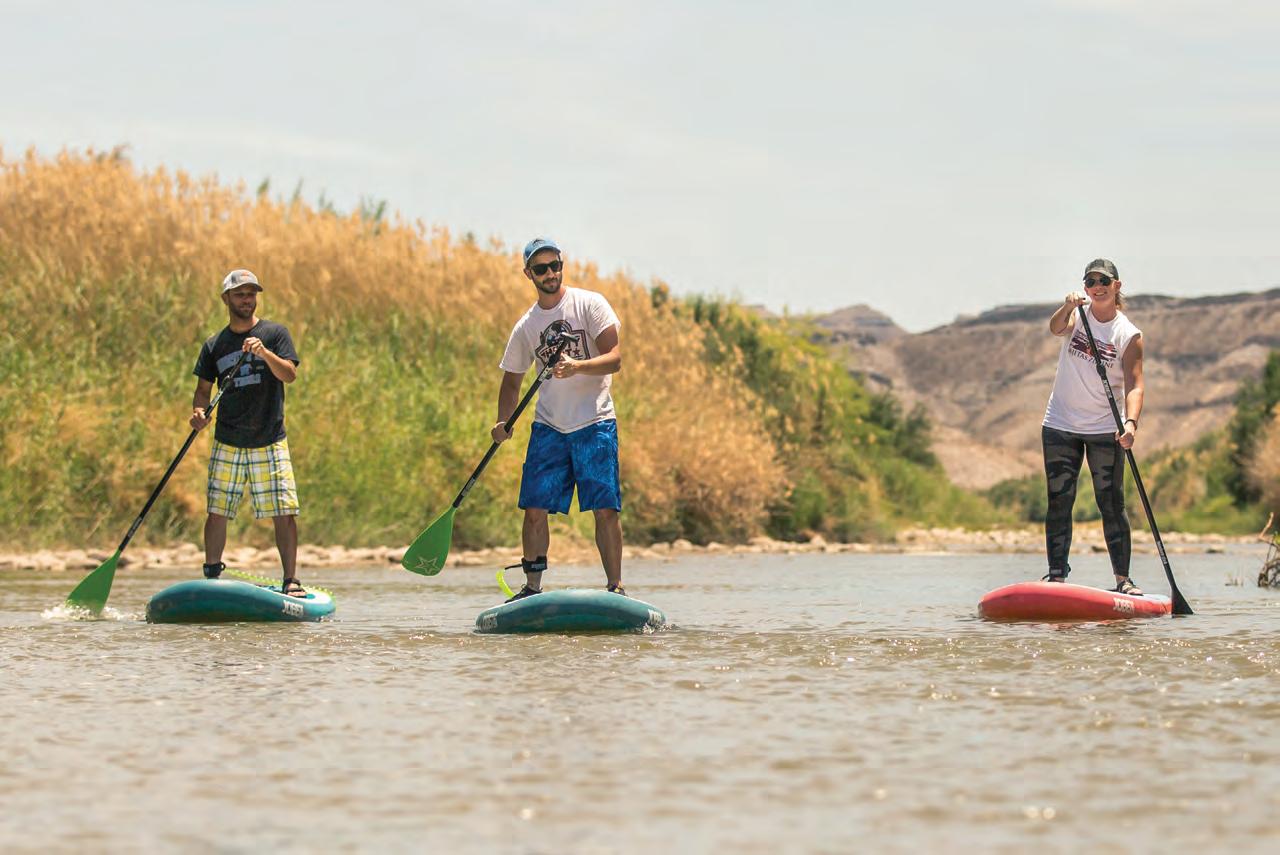
Get Competitive at Lake Travis Waterloo Adventures
Imagine a bouncy house, water park, and the reality show Wipeout all combined into one aquatic playground. This 600-foot obstacle course on Lake Travis delights guests with challenges like inflatable rope walls, trampolines, and slippery stretches to sprint through. (Don’t worry: All guests must wear life jackets for when they inevitably end up in the water.) For those who prefer to stay dry, the grassy shoreline offers loungers, food trucks, and land games. Reservations required, and water shoes are recommended. waterlooadventures.com
Tour the Ocean After Dark with Glow Row
See the Gulf Coast in a whole new (night) light. Every evening, this company leads visitors into various bays, wetlands, and harbors around Corpus Christi on clear kayaks illuminated by underwater LED lights. See an array of creatures swim beneath you as you learn about the history of the area from knowledgeable guides. All skill levels are welcome, and the rides are BYOB for attendees 21 and up. glowrow.com

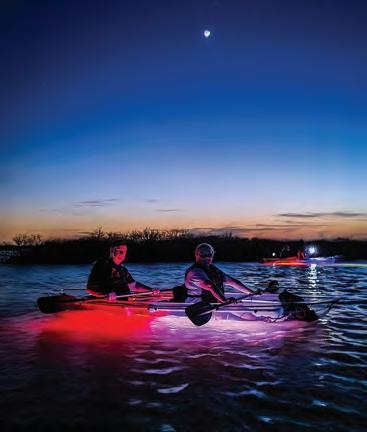

Attend a Sandcastle Competition in Galveston
Prepare to be dazzled by towering structures that are built to not last. Held at East Beach, this annual American Institute of Architects Sandcastle Competition is free and open to the public. Mark your calendar for the oceanside Aug. 12 showdown, when more than 60 teams will vie for the coveted “Golden Bucket Award.” aiahouston.org
Take a Dip at Balmorhea Pool
If you’re traveling west on I-10 toward Marfa, El Paso, or Big Bend, make a pit stop at legendary Balmorhea Pool. Built in the 1930s, the world’s largest spring-fed pool is a unique swimming destination offering scuba diving into otherworldly depths and caverns that
feed the water above. For those staying the night, Balmorhea State Park also has a network of campsites and a retro lodge for guests. tpwd.texas.gov/state-parks/balmorhea
Take a Stand-Up
With its slow and steady cadence, stand-up paddleboarding is like a moving meditation. Experience it like never before inside Big Bend National Park. Mariscal Canyon is the most remote spot, with an 11-mile trip that is only accessible by water, while Boquilla Canyon is the longest and deepest canyon, mapping 33 miles of adventure space. If you can make the time, it’s worth the three- to four-day river adventure to see the entire canyon. bigbendrivertours.com
Never mind packing up the car for a day in the sand: At Corpus Christi’s Lively Beach, you can access its namesake shore directly via a private boardwalk. The resort hotel features modern condominiums, an Instagram-worthy pool, and two rooftop decks with 360-degree views. Pro tip: If you want to cook a seafood feast—or even your own catch!—book one of its one- or two-bedroom rooms, which feature full kitchens. livelybeach.com

With his star turn in Top Gun: Maverick and an anticipated new Richard Linklater collaboration on the horizon, Austin-born Glen Powell is flying high.

BY GREGORY WAKEMAN

Ever the ebullient, beaming personality that he is, though, Powell is trying hard to downplay just how busy he actually is.
It’s January, and the actor is only in Los Angeles for a short period of time. Following the monstrous success of Top Gun: Maverick—which racked up six Academy Award nominations, near-universal critical acclaim, and a worldwide box office gross that’s nearing $1.5 billion—Powell has numerous back-to-back meetings with some of the biggest creatives in Hollywood. Never one to name-drop, he’s playing coy about this afternoon’s overloaded itinerary. But his cool veneer could also be credited to habit, as this type of attention has become routine over the past couple years.
In a flash, Powell has done the calculations on how long it’ll take him to drive across LA as well as the time necessary to mentally prepare himself for a meeting that’s in less than an hour.
Even while hurdling through these mental gymnastics, the 34-year-old Austin native is the personification of joie de vivre. This is the third time I’ve talked to Powell since the 2018 romantic comedy Set It Up, which exposed many of Netflix’s 230 million–plus subscribers to the actor’s leading-man potential. And not once has he strayed from the considerate, charismatic persona that a budding number of fans have learned to expect on screen. In fact, these chats feel less like an interview and more like catching up with an old confidant.
Even back in that first encounter, Powell couldn’t help but reverse course and dig into my own life. His curiosity unearthed the fact that we shared mutual friends working on the production of Set It Up. When promoting The Guernsey Literary and Potato Peel Pie Society in 2018—a film in which he only has a minor role—he was more than happy to geek out over the technical issues he helped solve on the Mike Newell–led film. Fast forward to the present, and he’s attempting to clear his calendar (and double our allotted time together) to discuss the crossroads he’s breached in his stardom.
“It’s been really wonderful to be a little nostalgic about my career,” says Powell, speaking in a low, introspective register. “It feels like the first act is over. And thinking about it has made me understand the journey.”
But Powell’s changing fortunes aren’t just the result of his effortless smile and contagious positivity—although those aspects have certainly helped.
“When I first met him, he wasn’t famous, but he already had this disarming quality,” says Powell’s Set It Up co-star Zoey Deutch. They were introduced on the set of director Richard Linklater’s Everybody Wants Some!! in October 2014, and quickly became close friends. “It was like this true old-school movie star energy,” she remembers.
Powell’s role as Walt “Finn” Finnegan in the coming-of-age comedy about a group of freshman college baseball players helped kick-start his thenstalled career. Even at that early juncture, his magnetism was palpable. If he walked into a room, everyone wanted to capture his attention. Yet, unlike so many performers of his caliber, Powell was actually thrilled to engage with everyone on set. “He’s never compromised that kindness to get where he is,” Deutch insists. “You root for him, both in real life and in his movies.”
It may not seem realistic for a Hollywood upand-comer, but Powell is, well... nice. Every person in his orbit fawns over his ability to make even the most timid feel seen and included. He’s someone who’s eager to share his knowledge, whether it’s a deep dive on the current movie landscape, a respect for classic films, or insight into where the industry is heading.
More than anything else, though, Powell fearlessly trusts his gut. Even if he has to take a step back to move forward.
That’s how he landed the role of Lieutenant Jake “Hangman” Seresin in Top Gun: Maverick. Initially in consideration for the part of Bradley “Rooster” Bradshaw, the film’s second lead (and son of Anthony Edwards’ beloved Goose from the original), Powell was ultimately beaten out for it by Miles Teller. But Tom Cruise, producer Jerry Bruckheimer, director Joseph Kosinski, and screenwriter Christopher McQuarrie were all taken aback by Powell during the audition process and offered him another supporting part instead.
There was just one problem: Powell despised the character.
As he reminisces, the actor becomes more and more animated. An incredulous grin spreads across his face as he recalls telling that dynamic quartet he was rejecting their overtures to be in one of the most anticipated blockbusters in decades. “I trusted my instincts and didn’t apologize. I was just like, ‘I hate this guy,’” he laughs. Powell just couldn’t envision portraying a pilot who was only in the Naval Academy because of his familial connections. “I believed so much that the character wouldn’t work that I fearlessly stated my point of view.”
Such was Powell’s conviction, that the Top Gun contingent instantly knew he was right for the part. So, to entice the actor, they proposed reworking the role using his council. “Instead of missing out on the experience of a lifetime, I had a serious impact on the way the movie came out,” he says.
The year-long experience, and Powell’s fortuitous decision to embrace the part of Hangman, proved transformative. Much of that success can be credited back to Tom Cruise, with whom Powell worked closely both on and off camera. The idea of “star
power” is hard to quantify in the industry, but Richard Linklater thinks it’s something his now-regular collaborator has grown into. The director has been in a unique position to witness that rise, having worked with him at starkly different points along his upward trajectory, including an early cameo in 2006’s Fast Food Nation. “It’s really hard to stand out in a Tom Cruise movie,” Linklater says. “So it was great to see him not fade into the woodwork.”
Starting with Dazed and Confused, Linklater had a front-row seat to the celebrity-making evolution of another smooth-talking Texan. A lot of the same magnetic qualities he observed in Matthew McConaughey he now sees in Powell. Like other creative muses throughout Linklater’s filmmaking career, such as Jack Black, Ethan Hawke, and, of course, McConaughey, Powell is now stepping into that role today. With their latest project, Hitman (set to open in theaters in late 2023), the actor isn’t just ready to step in the spotlight, he’s taking complete control of where that star is pointing. It’s been a long, arduous road from stage grunt to TV extra to scene-stealing sidekick.
Now, Powell is taking his turn as top billing on the biggest marquees, and the latest in a long lineage of Texas exports primed to reign over Hollywood.
WHEN THE CAMERAS aren’t rolling, there’s only one other place that Powell wants to be: his home city of Austin. “It just fills me up,” he says, proudly. “Austin is a city that makes me feel like the best version of myself. It’s young, it’s fun, it’s artistic, it’s full of music.” By the end of his hometown paean, I’m convinced he should take a run at mayor. Or maybe take up McConaughey’s position as Minister of Culture.
Growing up in the northwest part of the city, where he attended Westwood High School, Powell was taught from an early age to celebrate art, not judge it. “People are fearlessly pursuing their passions and doing things just because they want to,” he says. “That’s always just been part of the fabric of the town.” Every year Powell would see this firsthand at the annual South by Southwest festival. To this day, he still spends as many Sundays as he can watching new bands at Stubb’s BBQ.

But his passion for movies was ignited much earlier. In fact, he points to the summer of 1993, and a near-religious experience seeing Jurassic Park alongside his father. Like his later experiences untangling the technical minutiae on the set of The Guernsey Literary and Potato Peel Pie Society, a 5-year-old Powell was curious to peek behind the curtain and dissect the nuts and bolts of Steven Spielberg’s visual masterpiece. How did the storied director bring dinosaurs back from extinction? Not only did Powell go back to the cinema over and over for repeat screenings, he turned to the film extras when it came out on VHS.
Invigorated by Spielberg’s process, Powell began plotting his own sci-fi movies using a home video camera and an old computer that he repurposed into a motherboard prop for its spaceship setting. Almost immediately, he was coercing his friends to become castmates and mining other scraps in his parents’ house to become backdrops in his films.
The starstruck Powell was so hooked by the magic of cinema that he was determined to cast his own spell inside that enchanted universe—no matter how small the incantation. “I didn’t know if I was going to be a writer, actor, producer, or an entertainment lawyer,” he says. “I just knew that I wanted to be in the business.”
Ever encouraging, Powell’s parents, Glen Sr. and Cyndy, decided that the best course of action would be to get him into acting classes. By the summer of 2000, Powell was not only enrolled at the Austin Musical Theater, but cast in The Music Man as the understudy for Winthrop, the young male lead.
If the palpable creativity pulsing through the capity city, paired with cinematic spectacles like Jurassic Park, planted the seedlings of his talent, working on Austin Musical Theater’s million-dollar productions gave it the nutrients to thrive. A relentless rehearsal schedule, not to mention a first-hand glimpse of the necessary work ethic exhibited by the cast and crew, established the type of lofty parameters Powell would have to eclipse to have any sort of chance in the entertainment industry.
At the same time, that coterie of surrounding creatives were constantly reminding him to embrace the craft for the right reasons, and to soak up every minute on stage. No person emphasized these maxims more than casting director Donise L. Hardy. Seeing the embryonic star qualities that millions
“I'm feeling very grateful because
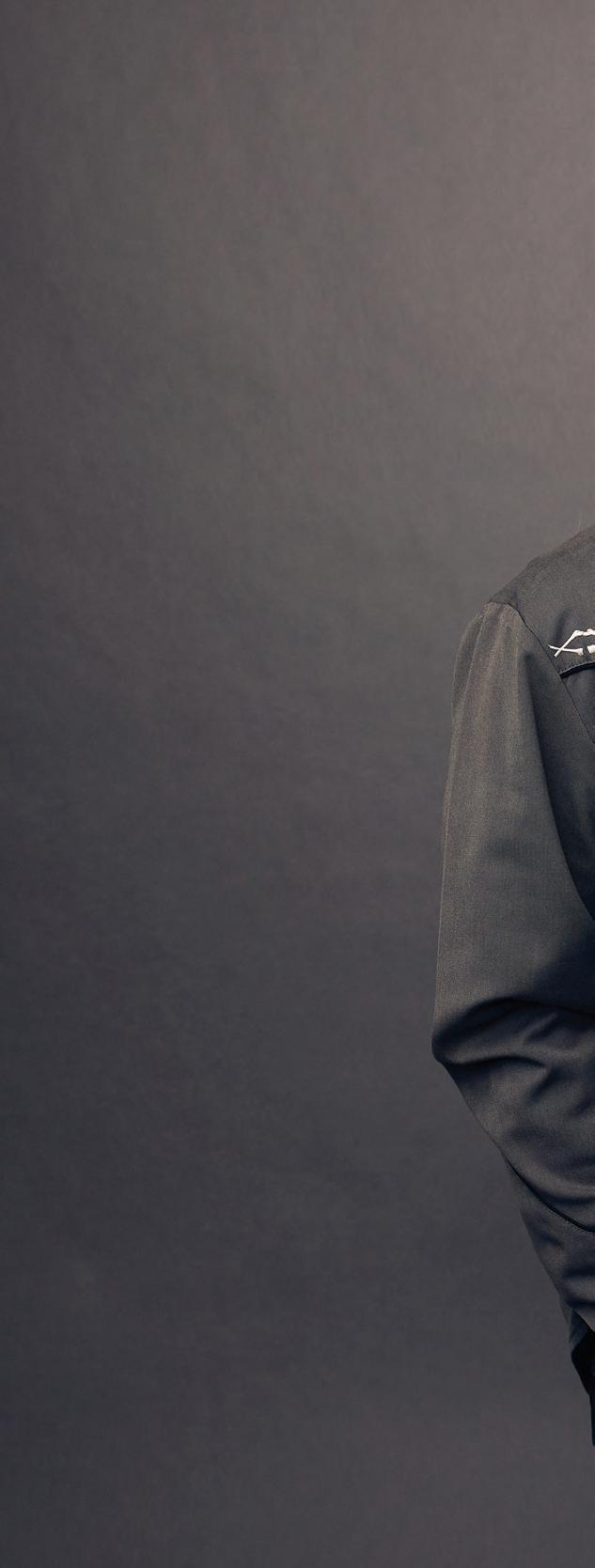

now I'm in the driver's seat.”
of filmgoers now adore, she pushed Powell’s talents forward for every commercial and film being shot near Austin. But rather than piling on any undue pressure at these auditions, she emphasized the idea of cutting loose. “She really celebrated actors,” Powell remembers. “She made me want to show people what I had. There was an intensity, but you never forgot that you were playing pretend.”
This approach worked, as a teenage Powell starred in Spy Kids 3-D: Game Over; Luke Wilson’s directorial debut, The Wendell Baker Story; and Fast Food Nation—his first, albeit brief, collaboration with Linklater. Such was his devotion to Austin that, despite the credits piling up, Powell refused to abscond to Hollywood.
That only changed when Denzel Washington, who directed Powell in The Great Debaters, encouraged him to make the move. “If you’re going to do this, this is the moment,” Washington said. “You’ve just got to jump in with both feet. It may not be quick. It may not be fun. But you’ve got to bet on yourself.”
Washington was right about one aspect of Powell’s eventual decampment from Texas: Success wasn’t quick. And, at times, the transition wasn’t much fun, either. While he found parts in The Dark Knight Rises, Stuck in Love, The Expendables 3, and Ride Along 2, they were either nameless (i.e. Trader #1, Good-Looking Frat Guy) or characters with minimal dialogue. “I failed for a very, very long time,” he muses.
Thankfully, Powell had his brand of dogged zeal to fall back on. “I decided I wouldn’t look at the industry as a competition. If I had, I would have been discouraged,” he says. “I had to repeatedly remind myself, ‘It’s not a sprint, it’s a marathon.’”
This might be Powell’s most admirable and defining quality: He has a knack for finding and amplifying the positive. Part of his signature alacrity could be credited to the fact that he’s always remained grounded. Even after moving out to Los Angeles in early 2008, he kept a homebase in Austin, vowing to never lose sight of his roots.
The city‘s impact on Powell has been so great that he now wants to return the favor to the artistic community that helped form him. Pointing to the early 2000s tax incentives that created thousands of jobs in the Texas film industry, Powell is vowing to lobby on behalf of their return. He’s also flirting with establishing his own local production company to draw more films to Austin. “I’d love to be at the forefront of a film and TV renaissance right here in the city,” he gushes.
An increasing involvement behind the camera should help Powell fulfill that commitment.
After nearly a decade in the acting wilds, the Austin actor has been emboldened by his involvement in major productions like Hidden Figures and Devotion (where he was co-lead and executive producer). “These movies really empower people,” Powell declares with the gusto of a politician at the podium. “They’re positive and transformative. I want to develop stuff that represents the ideas I want to put out into the world.”
That’s precisely what attracted Powell to his next film, which has reunited him with his Everybody Wants Some!! director. The 2014 opportunity helped relaunch his then-stagnating acting career, but Hitman is a true partnership, and the first in which Powell’s filmmaking fingerprints are present in every frame.
EARLY IN THE summer of 2020, during the making of Apollo 10 1⁄2: A Space Age Childhood, Richard Linklater received an intriguing phone call from a member of his cast. Powell was only playing a minor role in his latest rotoscoping endeavor, but the actor had bigger things on his mind—namely a 2001 Texas Monthly article penned by Skip Hollandsworth. Entitled “Hit Man,” it tells the story of Houston police officer Gary Johnson, who also worked undercover as the city’s most in-demand professional killer.
Made aware of the piece by Jason Bateman’s producing partner, Michael Costigan, he read the original article and became fascinated by its Hollywood potential. Although many had tried and failed to pull off an adaptation over the past decade, Powell wasn’t deterred.
Rather than attempting to position Johnson’s story in the framework of giant action set pieces, he envisioned it in terms of film noir like Double Indemnity and Lawrence Kasdan’s Body Heat. This story was a contemplation on passion and identity, not just gunfire and gore. And that all made Powell think of his fellow Austinite. “It’s dark. It’s twisted. It’s fun. It’s romantic,” he says. “There’s nobody who can execute that better than Rick [Linklater].”
Unaware of Linklater’s previous consideration of the story—which he dropped because of its lack of a third act—Powell managed to sway the director in just one conversation. With the country in lockdown, Linklater paced around his room talking plot, character, and that problematic ending.
Weekly brainstorming sessions quickly turned into near-daily meetings. Armed with Hollandsworth’s box of research about the case, the duo embarked on deep and intense planning conferences
The idea of “star power” is hard to quantify, but Linklater thinks it's something Powell has grown into.

that would zig-zag across a number of topics. Detours into discussing current events, baseball, and family became a thematic well to tap into as they searched for elements of humanity to impart on their script. Even when Linklater was riding his bike or Powell was on vacation with his family, their minds remained fixed on Hitman.
“I was walking with my family in this remote part of Maine. They’re 10 paces ahead of me, and I’m just on the phone with Rick breaking down the story. We’re talking about love and murder and identity. It started some really interesting family conversations,” Powell chuckles.
By the end of 2020, the pair finally had a detailed outline (“I’m an excessive planner,” Linklater admits). So positive was their rapport throughout the story’s early development that, during one of their chats, Linklater blurted out, “Should we just write it? I think we can write this together.” Unsurprisingly, Powell jumped at the chance, despite his lack of experience in that regard.
“Actors are often uncredited in the arc of creating a story,” says Linklater. “Just look at guys like Warren Beatty and Jack Nicholson. Glen made me think of Ethan Hawke in that regard. He has such great instincts and a great sense of character and story. I wanted to include him as early as possible.”
While Powell was shooting Devotion in April 2021, he and Linklater were constantly writing and sending pages back and forth, finishing the first draft of the screenplay within a matter of weeks. That fall, they headed to New Orleans, where Hitman was shot with Powell taking over as leading man, producer, and co-writer—a first in his career. His partner in the whole affair says it’s his most trans-
formative performance yet. “It’s a great character and a weird story,” he teases.
Seeing Powell reach such creative heights isn’t a surprise to Zoey Deutch. While making Everybody Wants Some!!, the two friends would exchange ideas and deliberate over their respective ambitions. Rather than leaving them to chance, they planned out exactly how those potential dreams could become a reality. This included remaining grounded, appreciating every single step along their path, and making sure that they helped one another as they progressed up the Hollywood ladder. That’s exactly what Powell did when he suggested her for Set It Up after Emilia Clarke dropped out to film Solo: A Star Wars Story instead. Now, as they’re both seeing the fruits of their labor, Deutch’s pride is tangible. “It’s so exciting to see him doing what he wanted to do,” she says.
Back in California, Powell has braved LA traffic and is finally pulling up to one of his many meetings that day. He apologizes for rambling, but he couldn’t help himself. There’s just so much going on with his career at the moment, including a TV remake of Butch Cassidy and the Sundance Kid, as well as a romantic comedy starring opposite Sydney Sweeney. With each new project, he’s carving out the future he’s envisioned since his days as Good-Looking Frat Guy. “I’m putting things together in the way I want,” he says. “I’m feeling very, very grateful because now I’m in the driver’s seat.”
If his time with Donise L. Hardy and Austin’s musical theater scene has taught him anything, there’s no doubt he’s going to have fun. And he’s certainly enjoying the ride.
Aformerhedgefundmanager turnedaltruisticdreamerplansto makeaburgeoningsportintoan Olympiccontender—andsave Americaintheprocess.


BY BRYAN C. PARKER
Gravel crunches beneath Steve Kuhn’s black-and-white sneakers as he strides across the parking lot of his sprawling 86-acre dominion 20 miles southwest of Austin. Here at Dreamland, you’ll find multiple mini-golf courses, disc golf, two outdoor live music stages, psychedelic art installations, a bar, and 16 courts dedicated to the fastest growing sport in America: pickleball. Teeming with whimsy and chill vibes, it’s an unusual place to find a Minnesota native and Harvard graduate who raked in a billion-dollar fortune on Wall Street before a lobbying stint in Washington, D.C. But, somehow, it tracks for Kuhn.
Clad in a pickleball hoodie and a matching red, white, and blue cap that proclaims “Pickleball will save America,” he’s unabashedly invested in his latest gambit. Wearing a steadfast almost-smile, it’s an expression that bears a wide-eyed optimism that might be mistaken for naïveté… if his track record didn’t prove that he could excel in some of the toughest rooms in the world. In fact, Kuhn is so pervasively good-natured that it might inspire skepticism. Like Ned Flanders, if Homer’s pious neighbor had the business acumen and foresight of Steve Jobs.
Kuhn is fond of referencing a quote typically attributed to Robert F. Kennedy, although it was originally lifted from Back to Methuselah, a play by George Bernard Shaw: Some men see things as they are and say, why? I dream things that never were and say, why not? It sounds grandiose, but it does a good job of encapsulating the ethos that has guided the entrepreneur through his multifarious career.
Originally, the site of Dreamland was purchased by Kuhn simply as a 9-acre property to house the production facility for Richard’s Rainwater, the bottled water company that Kuhn invested in heavily (and still holds
the largest ownership stake) in 2017. Eventually, the operation outgrew those digs, and the tract sat dormant until the would-be sports tycoon expanded its footprint by a magnitude of 10 and constructed the pickleball mecca that exists today.
It’s a chilly afternoon in late winter, and Kuhn has invited some buddies from his running group to check out his expansive playland. The cadre of retired men has gathered around Dreamland’s bar, and their ringmaster leaps behind the counter to pull a few drafts of foamy beer. “I think you’ve really got a tiger by the tail with this pickleball thing,” jests one of his running mates.
As co-founder of Major League Pickleball, Kuhn made a bold bet that has already begun to pay off. CNBC recently reported that over 36 million Americans played pickleball at least once between August 2021 and August 2022—up from just 5 million a year prior. That’s more than basketball, baseball, tennis, even golf, and far more than the country’s most popular sport, football. Undoubtedly, the proliferation of pickleball courts in city parks and recreation centers has created ample opportunities to play across the globe, but many people still find their way to Kuhn’s gathering place in Dripping Springs.
Dreamland has hosted several MLP tournaments that draw top talent from around the country, as the pool of prize money has grown from under $1 million to more than $5 million in just two years. In that time, its litany of investors has grown into a who’swho of notable names, including self-help guru Brené Brown, Milwaukee Bucks owner Marc Lasry, and elite athletes like LeBron James, Patrick Mahomes, and James Blake.
As Kuhn begins a tour of the grounds at Dreamland, a 3,200square-foot American flag ripples majestically in the February breeze above him. He gestures to the horizon, noting a pattern of large, vibrantly painted water tanks dotting the landscape. Vestiges of Richard’s Rainwater, these silos have become canvases for commissioned local artists to decorate with paintings of colorful balloons, aliens, mushrooms, and even Willy Wonka (a figure with whom Kuhn feels a strong kinship). Back when the property transitioned into Dreamland, Kuhn looked at the old storage tanks and told his staff: “We’re not getting rid of anything; we’re going to turn them into art.”

That may just sound like a cost-efficient way to repurpose assets, but in reality, it’s symbolic of everything Kuhn stands for. Inclusion and unity crop up even in short, casual conversation because he has a bold vision for the future. And everyone’s invited.
That slogan emblazoned across his patriotic cap? “I really believe that,” Kuhn says.
As he sees it, Americans show off their most admirable values when they’re bonding over something joyful—neutral ground often only possible in sports, particularly an egalitarian one everyone can play. Tennis has long been the preferred sport of leisure, but with a court roughly one-third the size, pickleball brings players even closer. For Kuhn, the sport fosters camaraderie and possesses an everyman spirit that connotes the fundamental tenets of our nation.
“When this country is at its best, it is the most special and amazing place in the world,” he says. “I’ve argued the phrase ‘the American dream’ is the most powerful brand in human history, and I’ve worried for the last couple decades that we’re hurting that brand.” For someone with his background in business, there’s no doubt that Kuhn considers the financial implications in pickleball’s meteoric rise. But, for him, there’s far more to the game— something deeply philosophical that speaks to the essence of the human spirit.
IN AN APRIL 2016 letter to clients, Kuhn announced his sudden departure from Pine River Capital Management, the Wall Street hedge fund

he’d built into one of the industry’s most successful traders. The company’s fixed income fund posted a 93 percent return in 2009 thanks to housing industry investments, but Kuhn felt he’d already made his mark. It was time for something new.
“I am searching for the narrow gate, trying to take a new path in life,” he told Bloomberg Television, citing his brother and two different Austinbased reverends as influences in the decision.
In hindsight, Kuhn also credits reading Australian moral philosopher Peter Singer’s book The Life You Can Save. Soon, he was hard at work with a bevy of philanthropic organizations, including the Nobelity Project, an Austin-based nonprofit focused on building classrooms and libraries in Kenya, Honduras, Mexico, and Texas. There was also Charity Water, which works to bring clean water to people around the world. Reminiscing about the documentary that introduced him to the latter’s mission, Kuhn says, “If you don’t cry in the middle of it, I won’t think you’re human.”
As he traveled the globe and immersed himself in humane causes, Kuhn couldn’t help but look back at his own homeland and reflect on how it could play a bigger part in bettering the lives of others. “We’re not as welcoming to people from all over the world as we used to be—and that’s true in red and blue administrations,” he says.
Thinking about a better approach to immigration gripped his imagination, and in no time, Kuhn had mapped out something he called IDEAL Immigration (or Immigration Designed to Enhance American Life), which was intended to create a protocol for more streamlined legal entry into the U.S. Through mutual friends, he got in touch with a longtime lobbyist named Rhod Shaw to gain a foothold with Washington lawmakers.
In a multi-decade tenure in the nation’s capital, Shaw’s firm, the Al-

pine Group, took a bipartisan approach to helping politicians and industries find practical approaches to legislation. Similarly, Kuhn had no interest in party alliances and had come to Washington with a singular focus. “When I introduced myself to people, I called my introduction a sentence of the three jokes: I’m here to talk about rational… bipartisan… immigration reform,” Kuhn says. “That kills in D.C., by the way.”
His vision hinged on pragmatic solutions that were designed to help people—even if the plan wasn’t mere altruism. Additionally, it would strengthen the nation, bolster the economy, and help the planet. “When he sits and rolls that out to people, their minds kind of explode,” Shaw says. With a motive stemming less from profit and more from a hope for global improvement, Kuhn was hard to size up for people on the Hill.
Still, the duo forged ahead, securing meetings with hundreds of lawmakers, with most warming to Kuhn’s plan. But every politician that liked the idea almost inevitably pointed to the other side of the aisle: They would never go for it. “In the financial world, you can see an opportunity and you can move on it,” Shaw says. “In Washington, being right is not nearly enough.” That reality presented an obstacle for Kuhn, whose empirical data didn’t always have the desired effect. Undeterred, he kept at it for almost two years.
Any success in Washington might not have the same tangible return on investment as Kuhn’s Wall Street days, but Shaw insists that the impact was very real. “It takes decades to move major policy,” he says, citing new data points and legislative language added to the discourse. In other words, it helped shape attitudes, if not laws on the books. Ultimately, Shaw sees a parallel between Kuhn’s immigration push and his new foray into pickleball: “The guy has the vision to put something together that wasn’t seen before.”
Although Kuhn left the district behind in 2020, it would be foolish to think he’s given up his immigration pursuit—the approach just looks vastly different. He’s found a way to talk about it, enact his concepts even, through a microcosm in the form of a rising sports league headquartered right here in Central Texas.
ON A WARM September day in 2022, Lina Padegimaite made her way out of Austin, past the ever -bottlenecking traffic at the Y in Oak Hill, and arrived in Dripping Springs. Crossing over the cattle guard and onto Dreamland’s ranch feels a bit like passing through a portal to a dimension that’s both foreign and familiar.
After growing up in Lithuania, Padegimaite spent her college years playing tennis on a full scholarship at the University of Texas at Austin, so she’s no stranger to the capital city. Yet starting a new chapter as a pro pickleball player, in Kuhn’s peculiar hamlet, has made it feel like a completely fresh start. “There’s just so much space; it feels open and like there’s room to breathe,” she says.
Padegimaite is one of four international players living on the Dreamland grounds. There’s Dekel Bar, a former tennis professional who moved to the U.S. from Israel in 2020 and is now one of pickleball’s top-ranked men. Vivienne David hails from Canada. And rounding out the boarders is DJ Young from Spain. All of them are housed in modular tiny homes that Kuhn had trucked in as part of his plan to grow the sport and emphasize his goal of global unity.
“One good player draws more good players, and everyone feels like they have to be part of high-level training groups,” Padegimaite says. “It’s a domino effect.”
What’s more is that the pros can teach lessons to beginners and casual players. In effect, their residence at Dreamland bolsters pickleball at both ends, sharpening top-tier talent while enticing newcomers. It also serves as a conduit between those two worlds, putting fans in close proximity to budding stars—something unheard of in any other major league sport.
Ever the insightful businessman, Kuhn also saw a need to organize the massive influx of new players, which led to the development of the Dynamic Universal Pickleball Rating System (DUPR) shortly after the founding of MLP. When logging onto pickleball websites and forums to scrounge up a match, players need a way to link up with others of similar skill levels, whether novice or pro. Receiving a ranking solves that issue.
Perhaps most importantly, Kuhn has also been able to wrangle marquee names to join MLP as team owners and figureheads of the league, including Kevin Durant, Tom Brady, and Drew Brees—partnerships that have snagged headlines and accelerated the sport’s growth. Those investments have come in part because of a pickleball boom that has seen tennis courts across the country repurposed to make way for its more popular little brother. But Kuhn’s charisma and tenacity have also played a role. “He has such a huge personality but his genuine and deep passion for the sport is exactly what you want from someone who is occupying the role of steward,” Brees says.
The former New Orleans Saints quarterback played high school football in Westlake, a short jaunt from where Dreamland sits today. As such, he’s got some insight on the city’s prospects as a pickleball launchpad. “Looking at the rapid emergence of

“I’ve argued that the phrase the American Dream’ is the most powerful brand in human history.”
Austin as a major leader in innovation across the business landscape, it would seem to reason that being the hub for the fastest-growing sport in America adds up,” he says.
Austin has expanded so quickly that it’s overdue for more major sporting endeavors. In a city renowned for startups and off-the-wall thinking, it makes sense for pickleball to take root, particularly if pro baseball or basketball never materialize. Earlier this year, MLP announced a deal with the Tennis Channel to televise matches, and the league has also aired tournament play on CBS Sports. With the rise of streaming options in lieu of traditional television services, a tech hub like Austin could further embed itself into the proliferation of a progressive new sport.
Kuhn may be the pickleball king of Dripping Springs, but he’s not the pickleball emperor of the world. At least not yet.
There’s still much to be determined, and competition is rife. The MLP recently formed an alliance with the Professional Pickleball Association (PPA), but its similarly named opposition, Association of Pickleball Professionals (APP), looms ominously. Each league endorses slight variations in the game’s rules, and the APP has a reputation for appealing to amateurs moreso than Kuhn’s ventures.
In a significant move, the APP recently inked a deal with Universal Tennis Rating, the longstanding organization that provides ranking levels for tennis players around the world. That move could make the more established entity a one-stop destination for determining one’s official rating for both racquet-based sports. However, even if DUPR doesn’t prevail in this direct challenge, MLP is still well-positioned with established tournament play and flashy brand ambassadors that carry the cachet of LeBron James.
In short, pickleball is a long way from the kind of entrenched interests found in the NBA, NFL, MLB, or NHL. For now, it’s the Wild West, and it will take some time before the dust settles. The future may reveal one league to be the leader, or there may be a merger down the line, such as there was with baseball’s American and National leagues.
As the business landscape of pickleball continues to unfold, Kuhn stays laser-focused on growing the sport however he can, which includes lobbying hard for its adoption as an official sport at the 2028 Olympic Games in Los Angeles. For now, the IOC isn’t sold, but there’s time for that to change. And as anyone who knows Kuhn will tell you, he’s not giving up.
This is a guy who helped turn $5 million into $14 billion in a few short years. Who made a business out of bottling rain. With the path paved for pickleball’s explosion, it needed someone with the means and vision to provide a spark. And it just so happens that Kuhn was looking for a way to prove that uniting people around the world is a beneficial (and lucrative) idea. He likes to say that America needs pickleball. But it seems just as true that pickleball and Steve Kuhn needed each other.







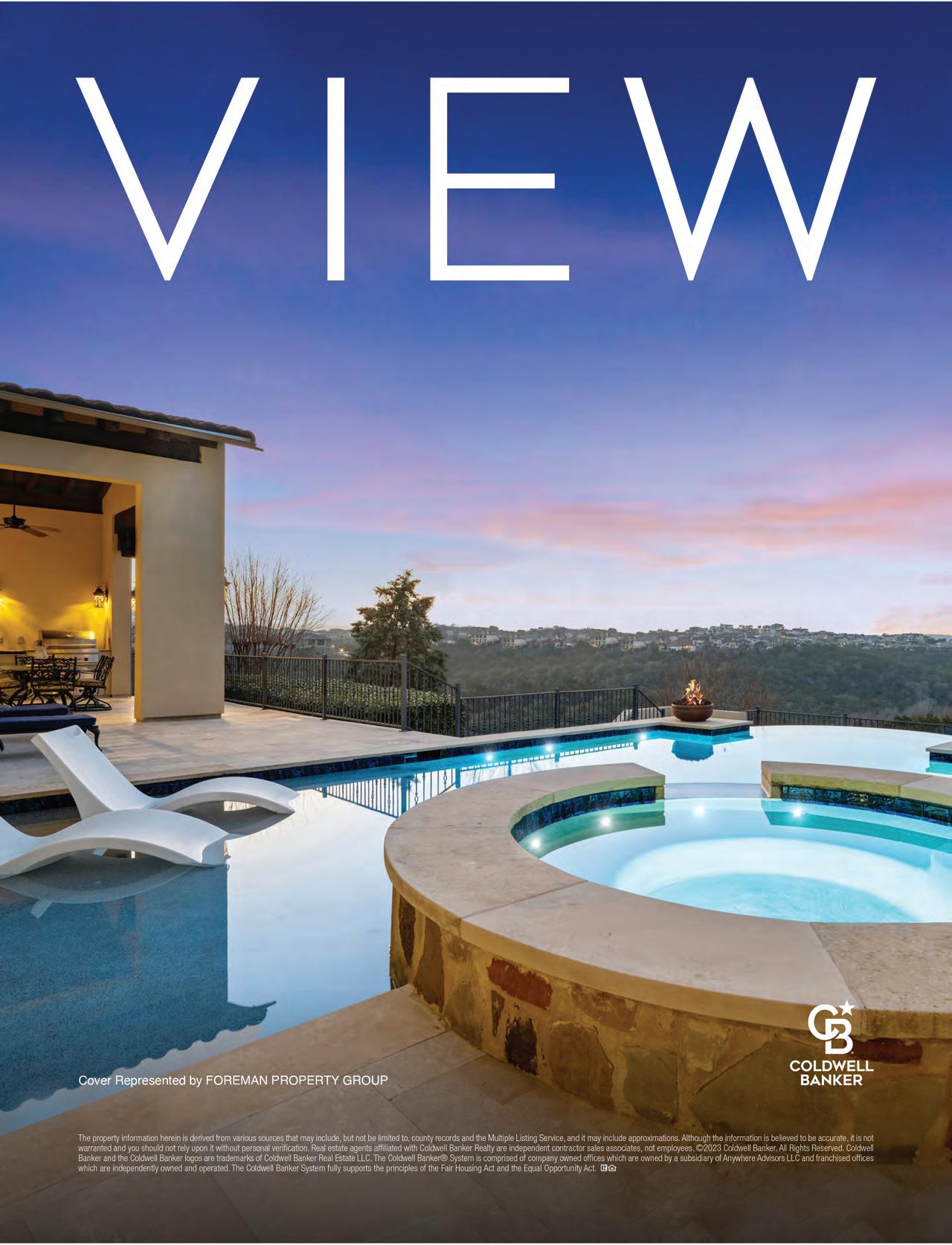







Home to rodeo clowns, nudists, and fad-fueled dieters, the Lake Austin Spa Resort site has seen the wildest roster of guests.
BY ROSIE NINESLING
AT THE FIRST bend in the Colorado River, five miles below Mansfield Dam, sits 12 acres of waterfront property hidden from the public eye. Today, it harbors one of the country’s top holistic destinations, but if you ask Cindy Present, Lake Austin Spa Resort’s director of wellness, she’ll tell you that the history of the land has always been colorful.
Started as a fishing camp in the 1940s, the location acted as a magnet for the middle class in search of a summer getaway. But as the ’70s rolled in, decades of road-tripping families were replaced with the Sunshine Nudist Camp (who were also seeking a good time, sans bathing suits). The colony’s early optimism was also laden with oversight, and they quickly ended their lease with the onset of winter.
Steiner Ranch rodeo clowns were briefly lodged and trained on the property, but the real attraction came in 1978 when The Bermuda Inn reducing
resort began its regime. Daily intakes maxed at 500 calories, dietetic cocktail hours, and the incentive to “lose a pound a day, the fun way!” made it a hot spot for those in search of a new body. For motivation, the inn released their own exercise cassette tape featuring “The Diet Song,” a Shel Silverstein original written for the camp.
Thankfully, fads faded, and as the definition of health changed, so did the property. Lake Austin Resort transformed the concept, and in 1994 added “spa” to their title, replacing celery dinners with celebrity vacationers. Committing to wellness instead of waistlines, it’s become a premier destination for holistic care.
“Looking at the lineage of the property, it’s been a camp in various stages,” says Present. “As a kid, we go to camp to have fun, to refresh, to kick off summer. As an adult, you never lose that desire.”

